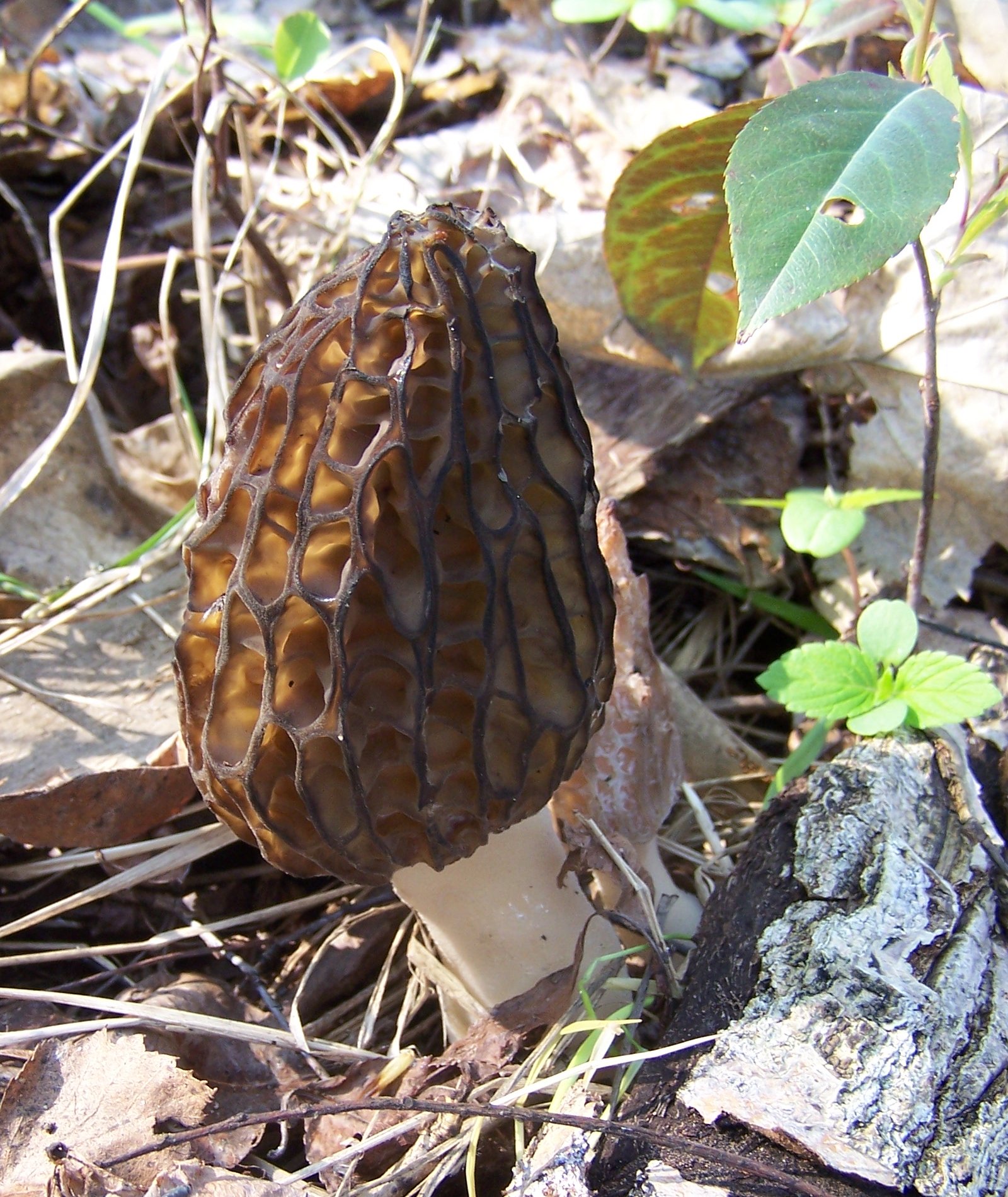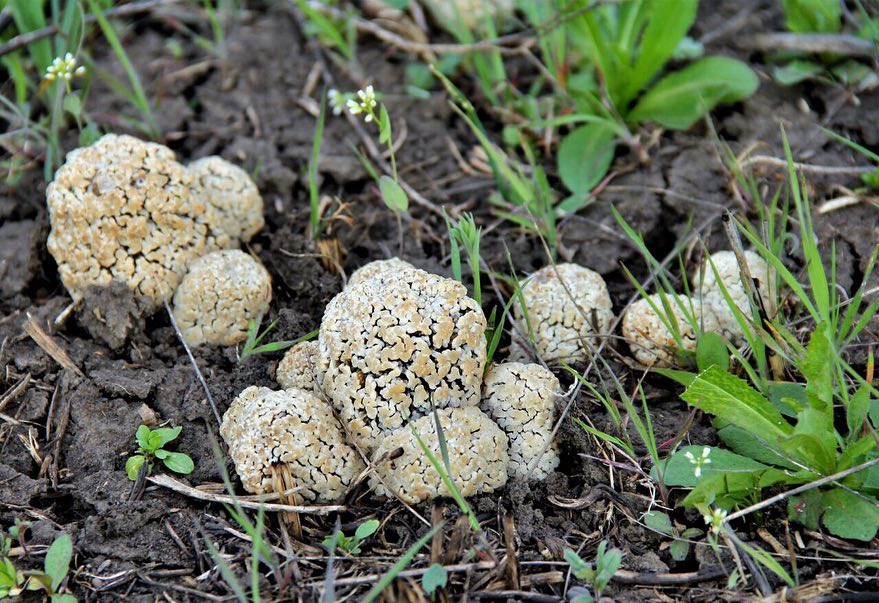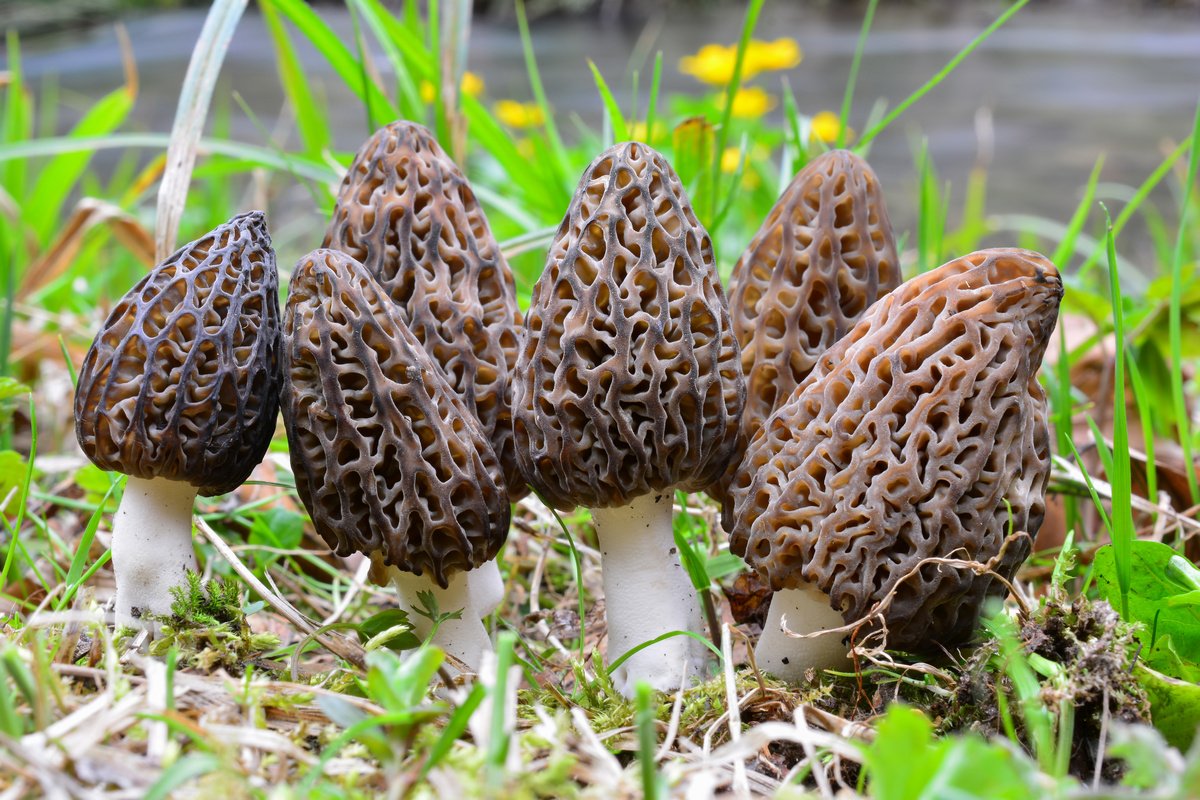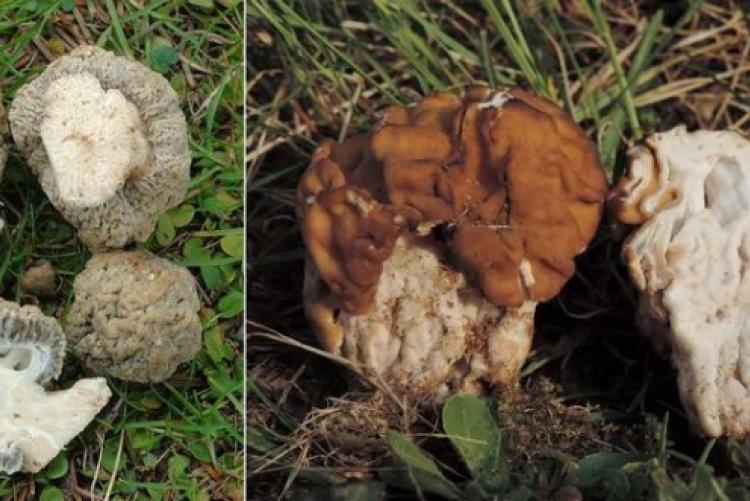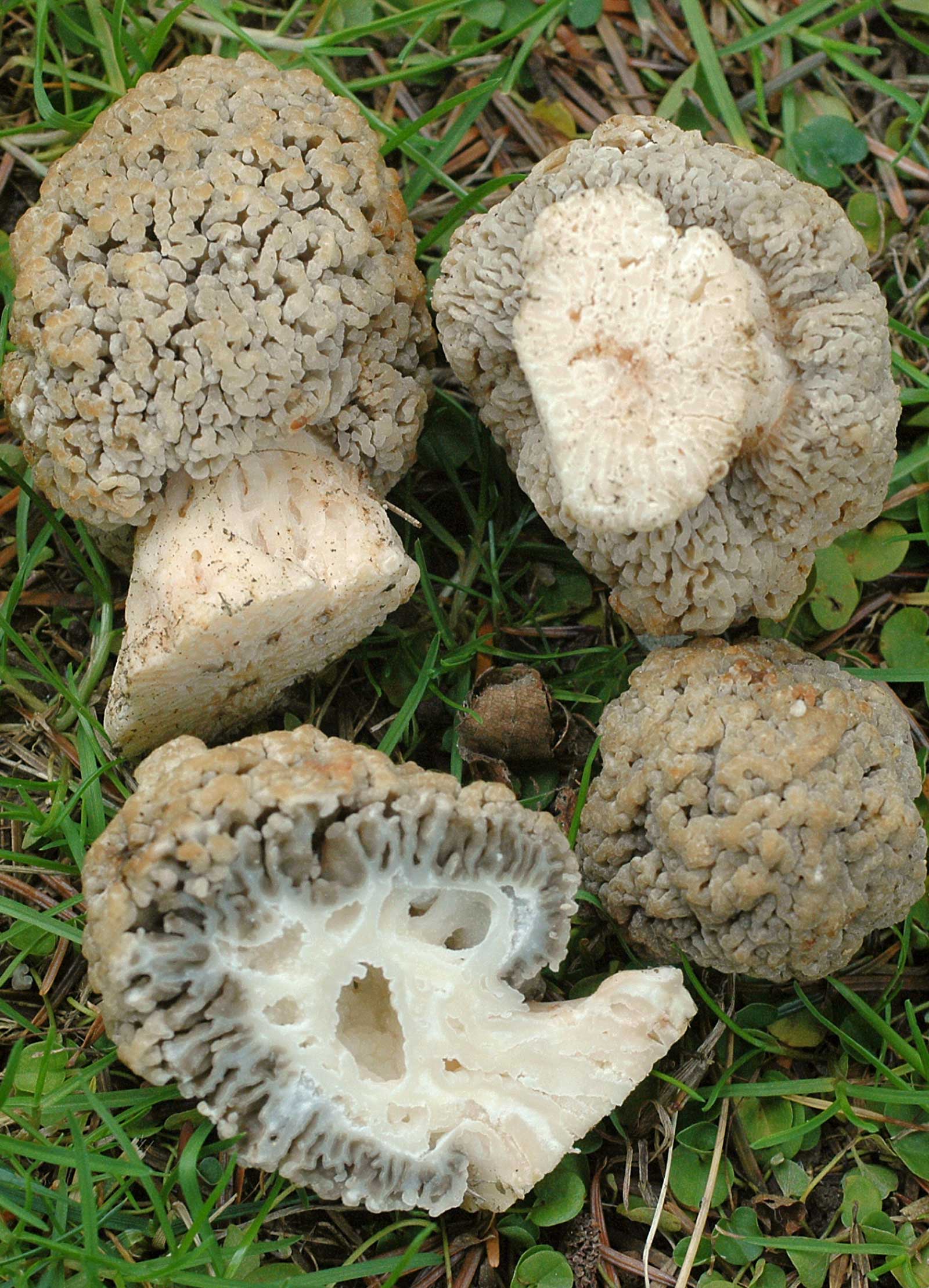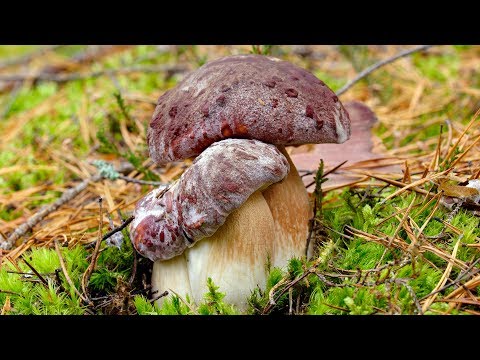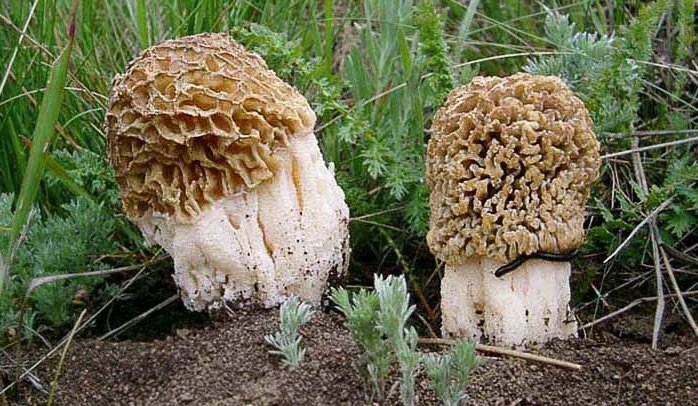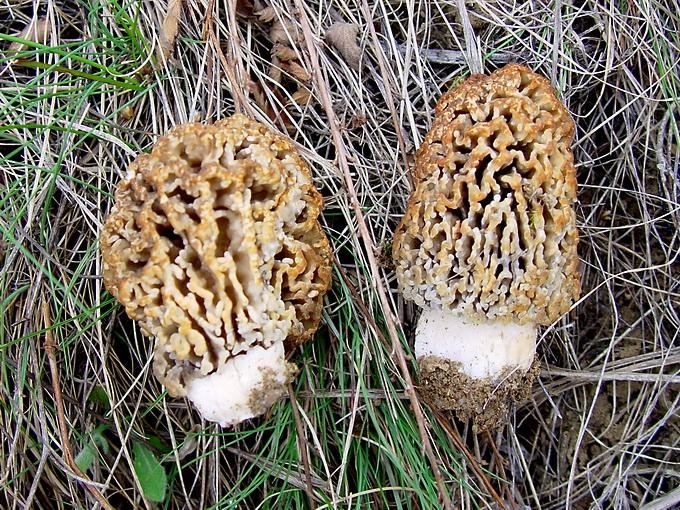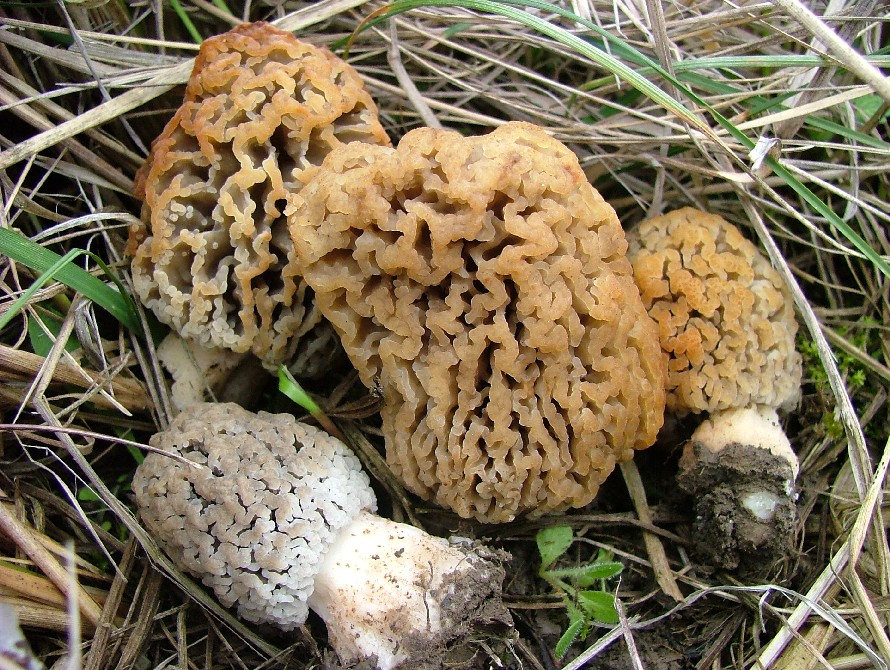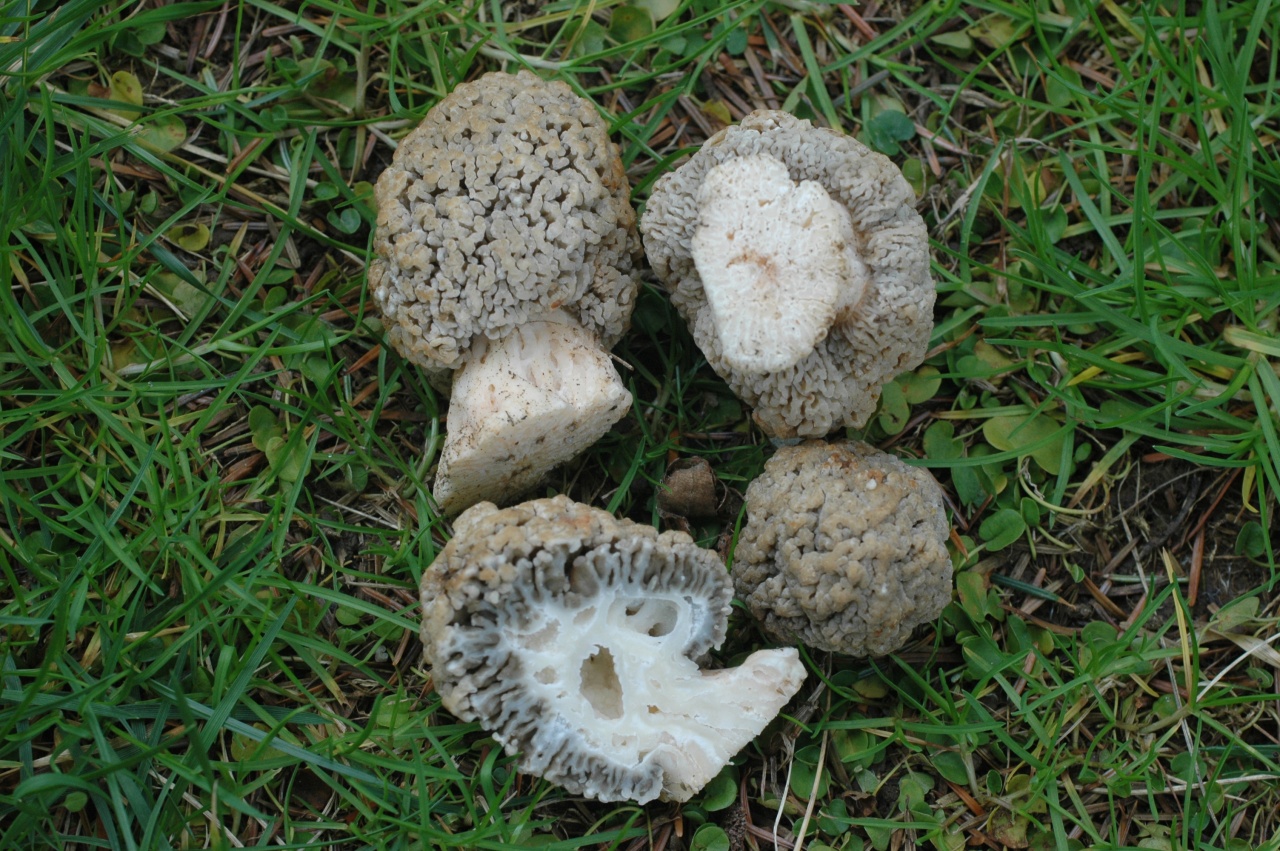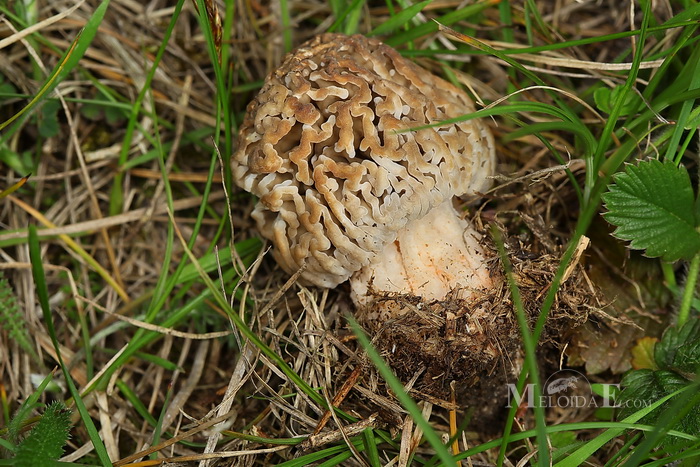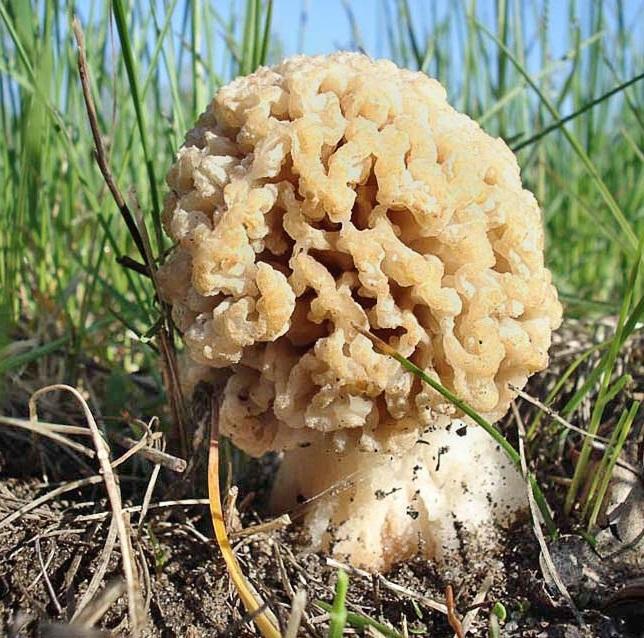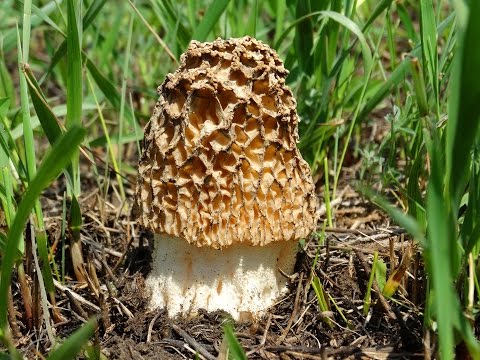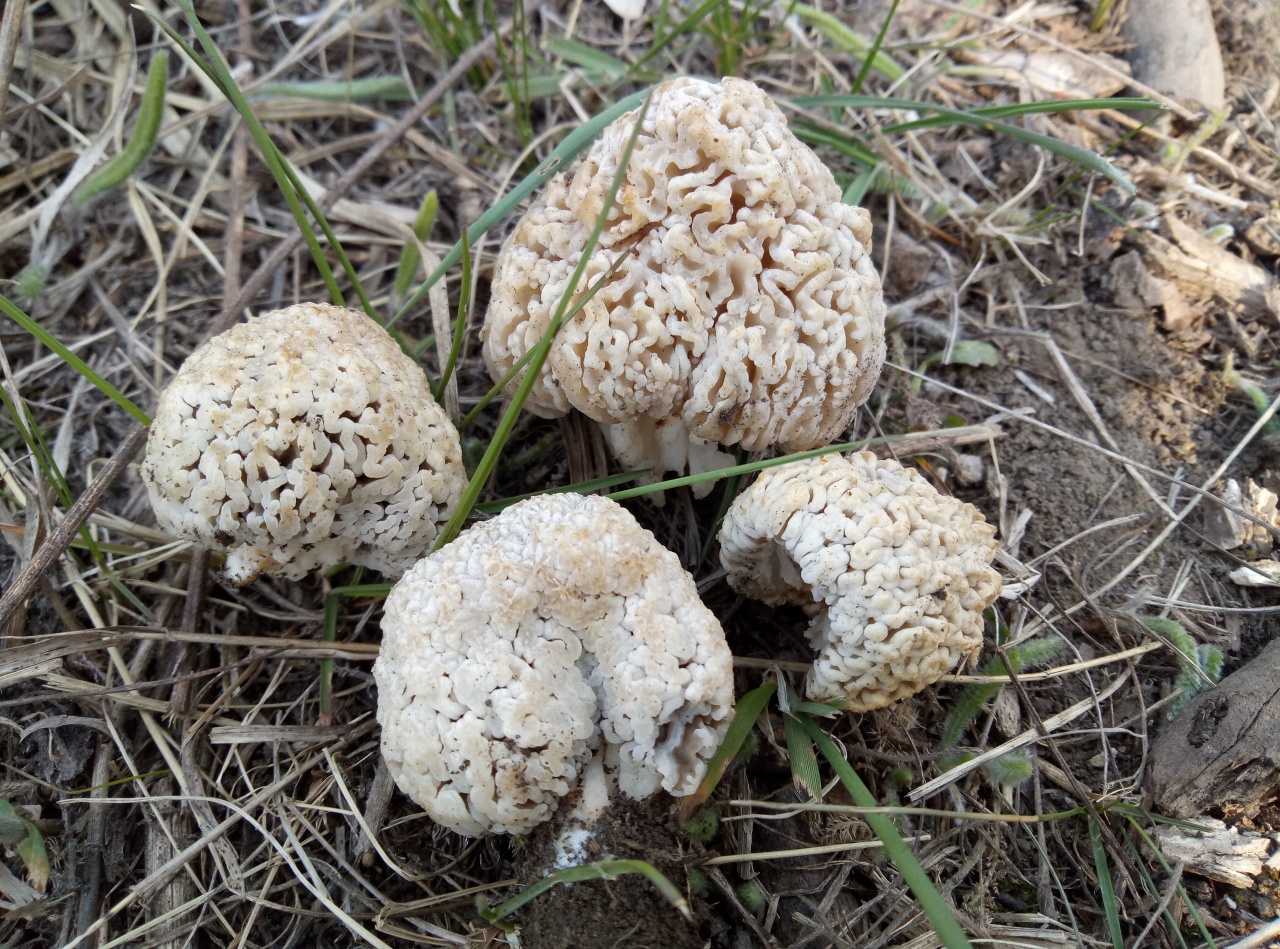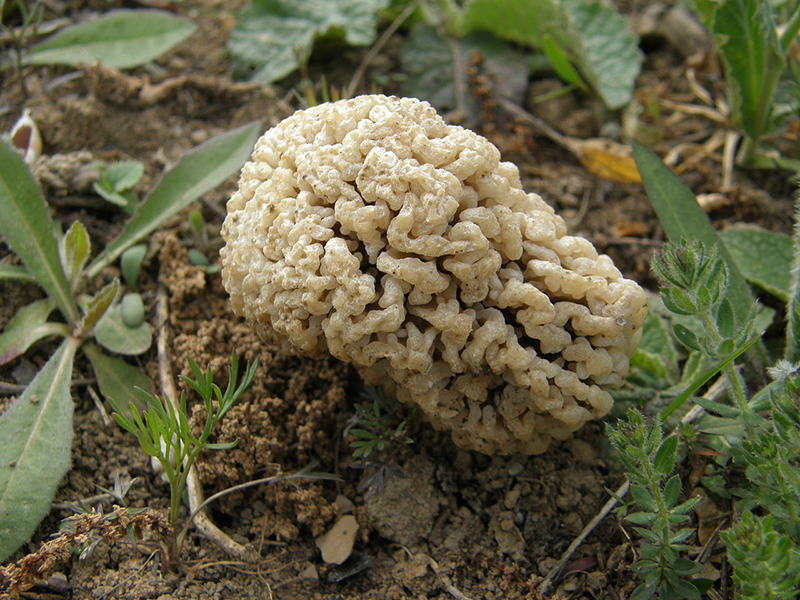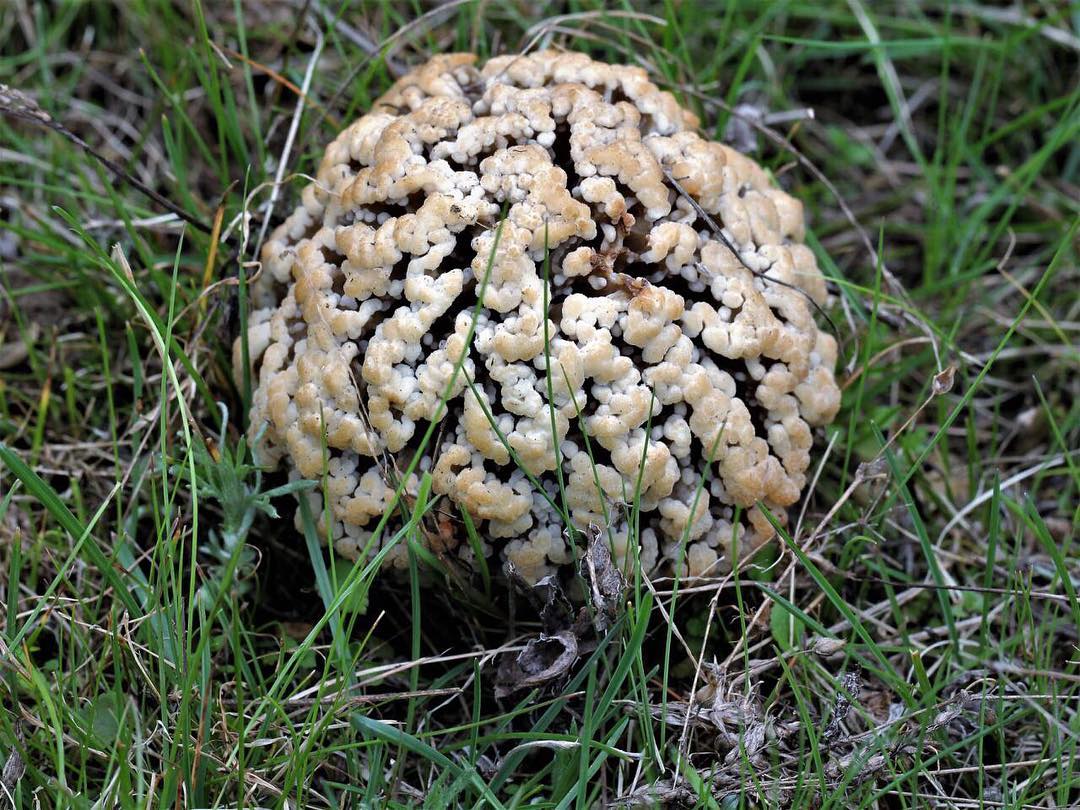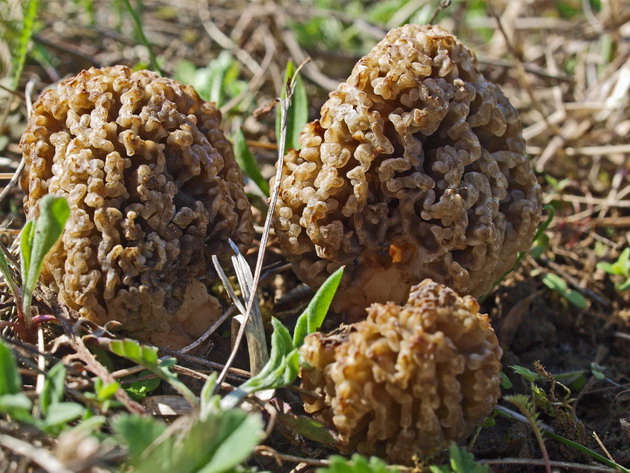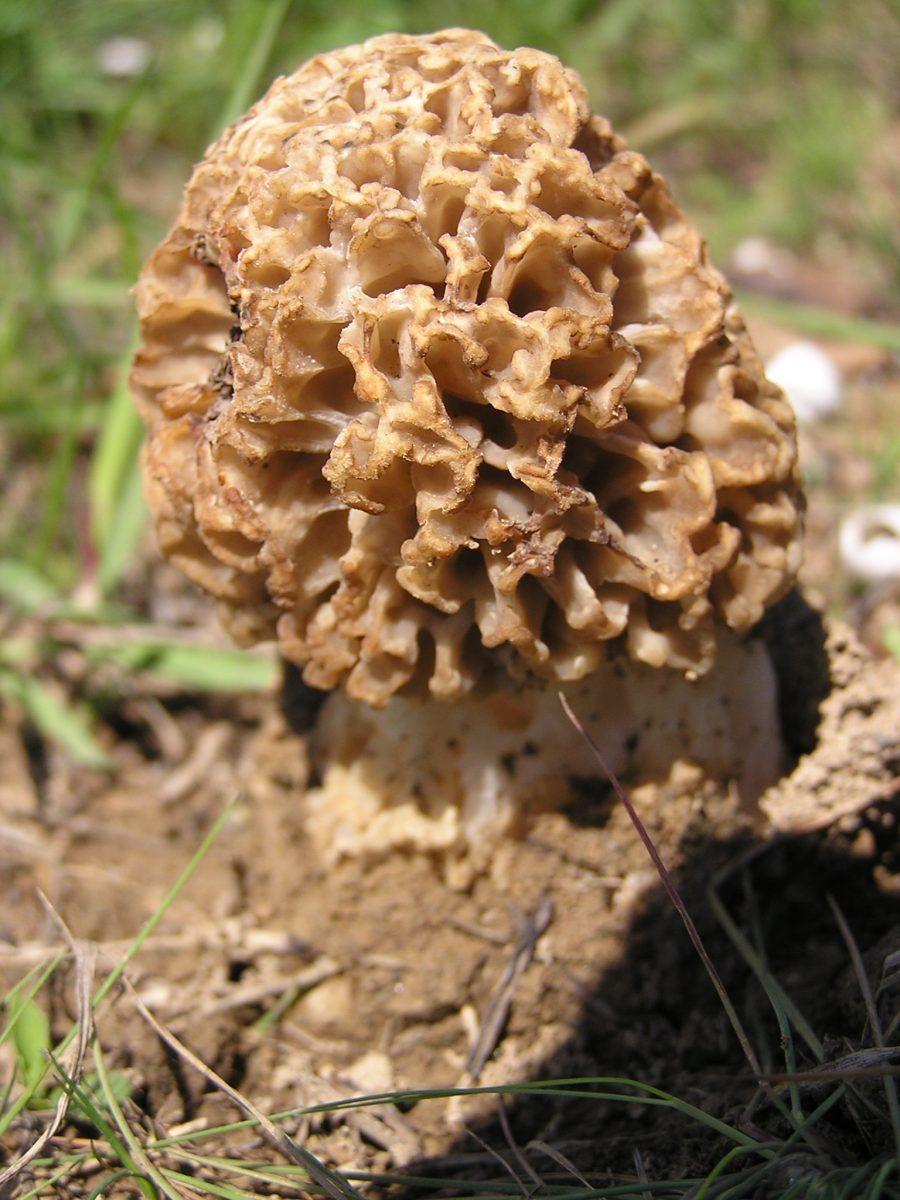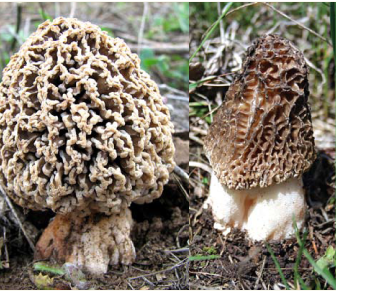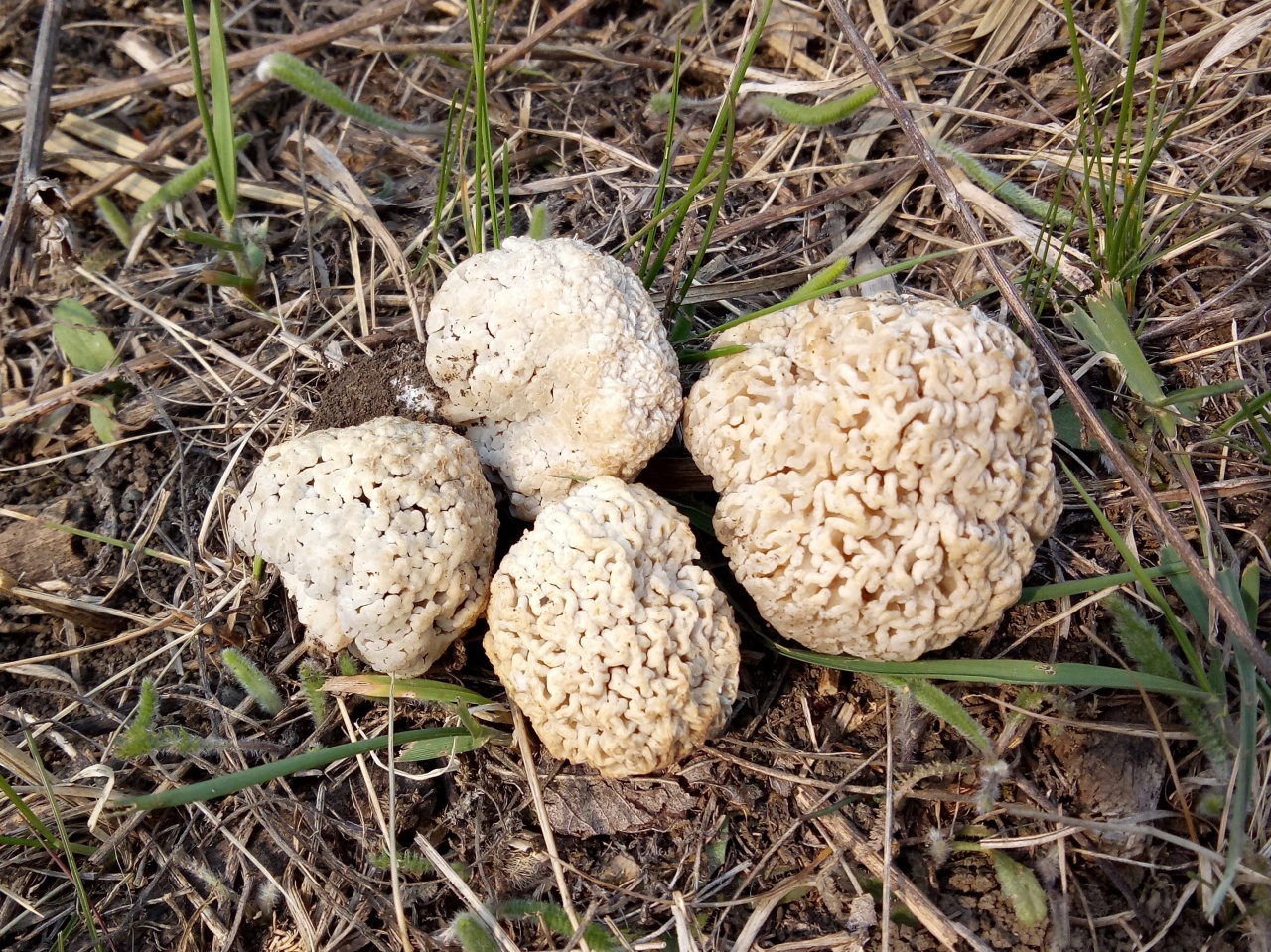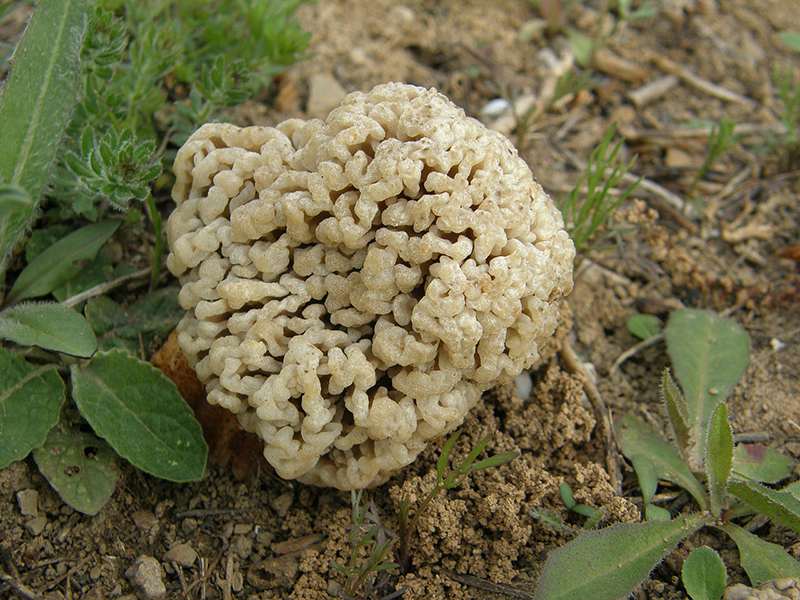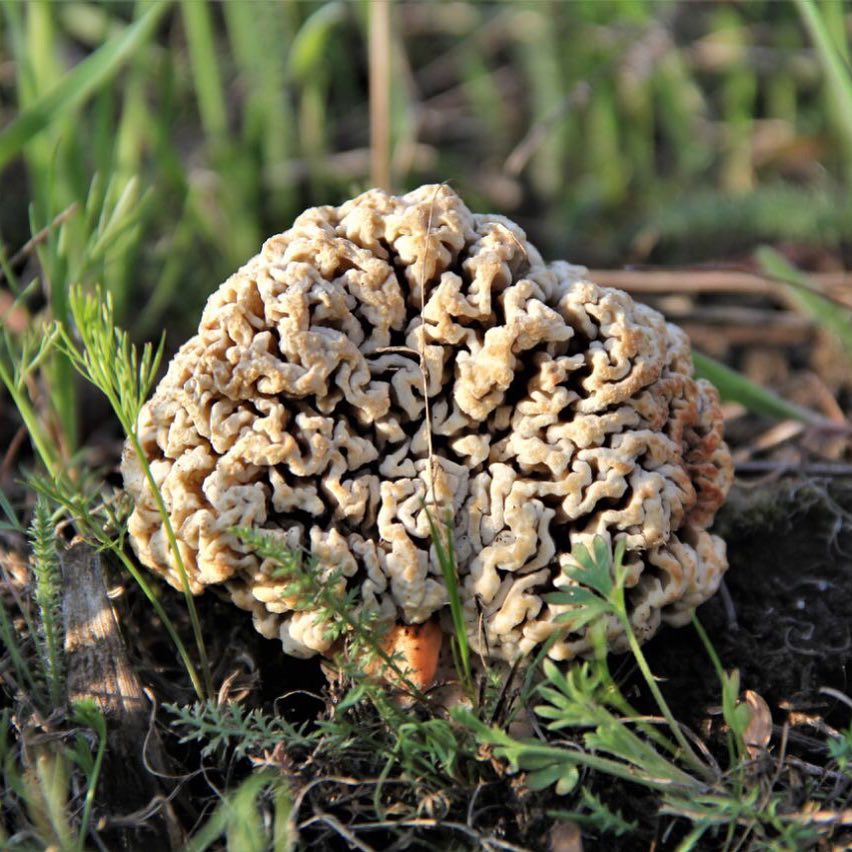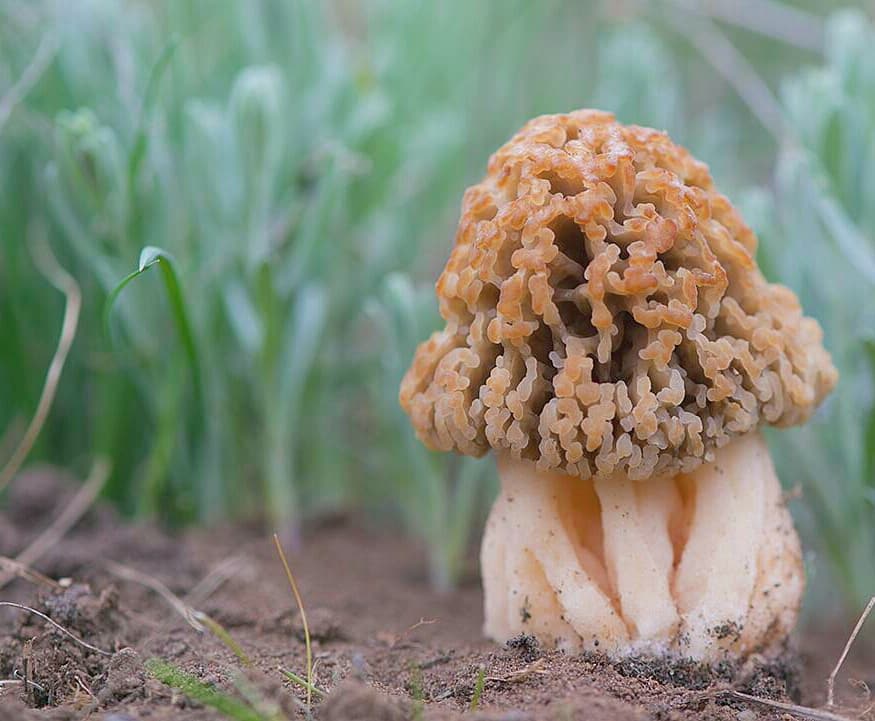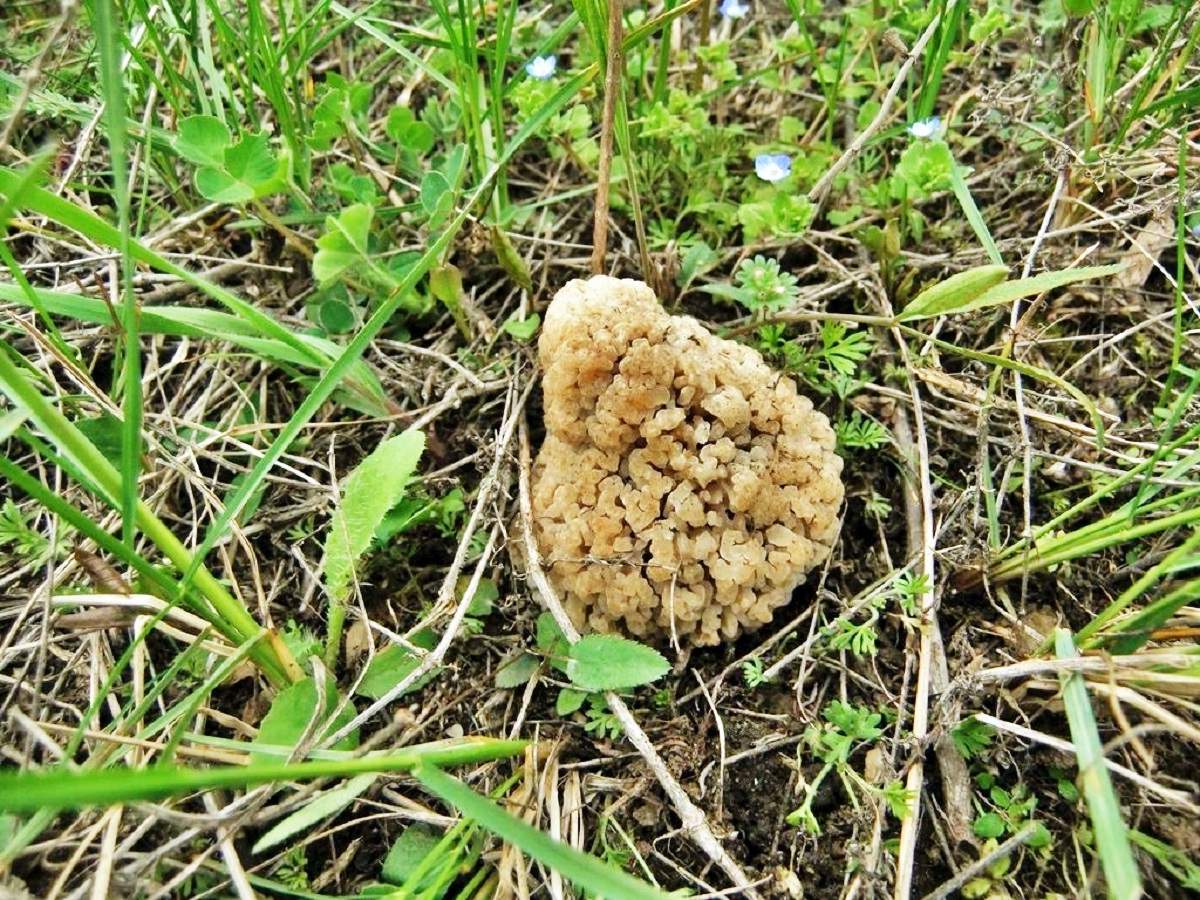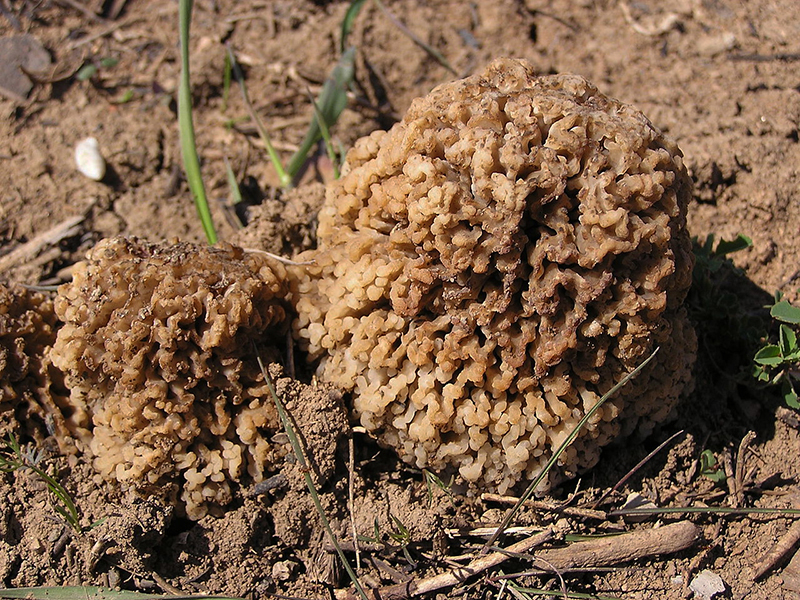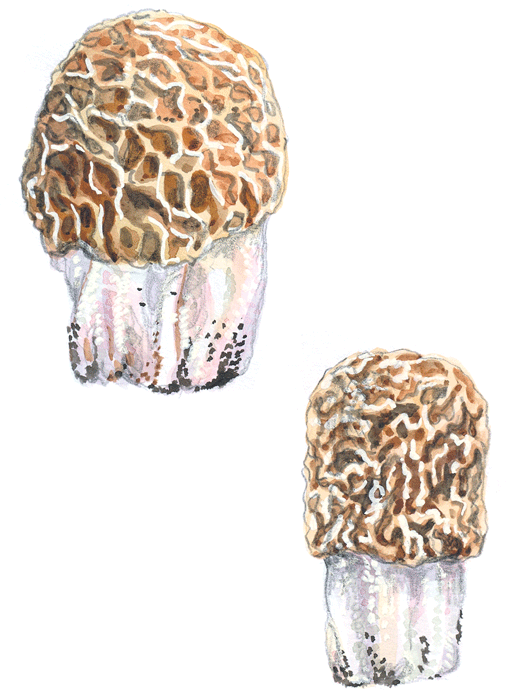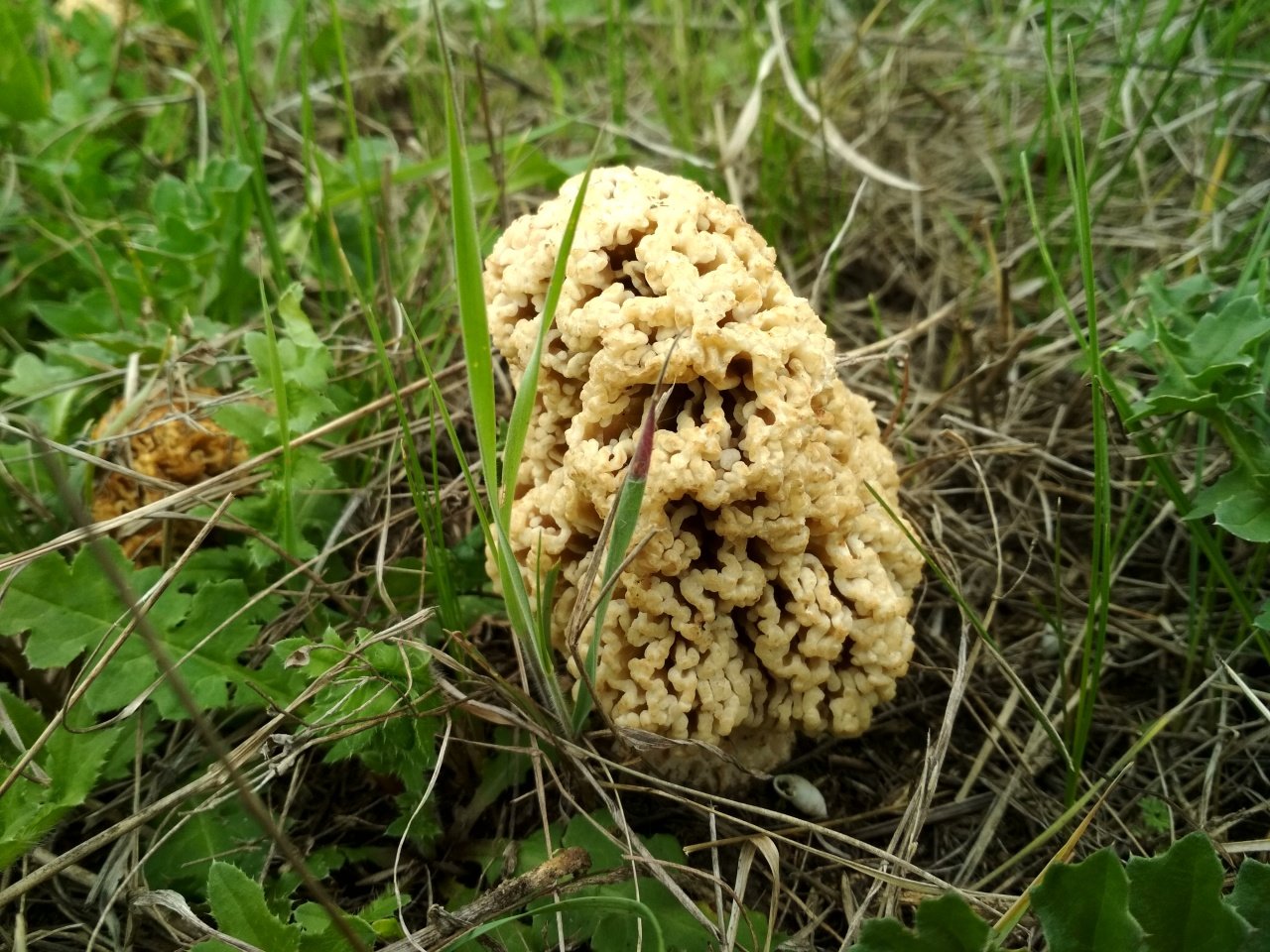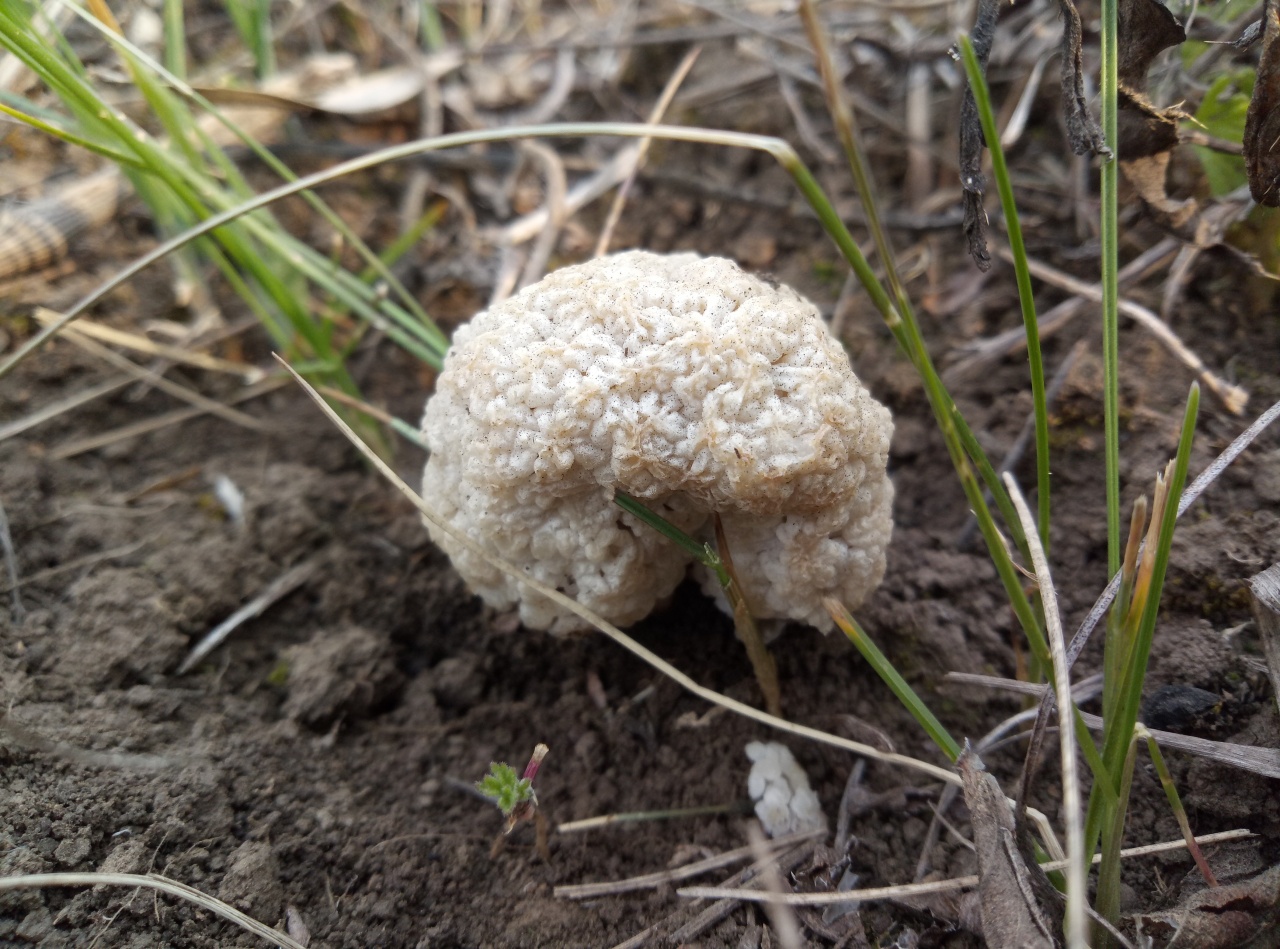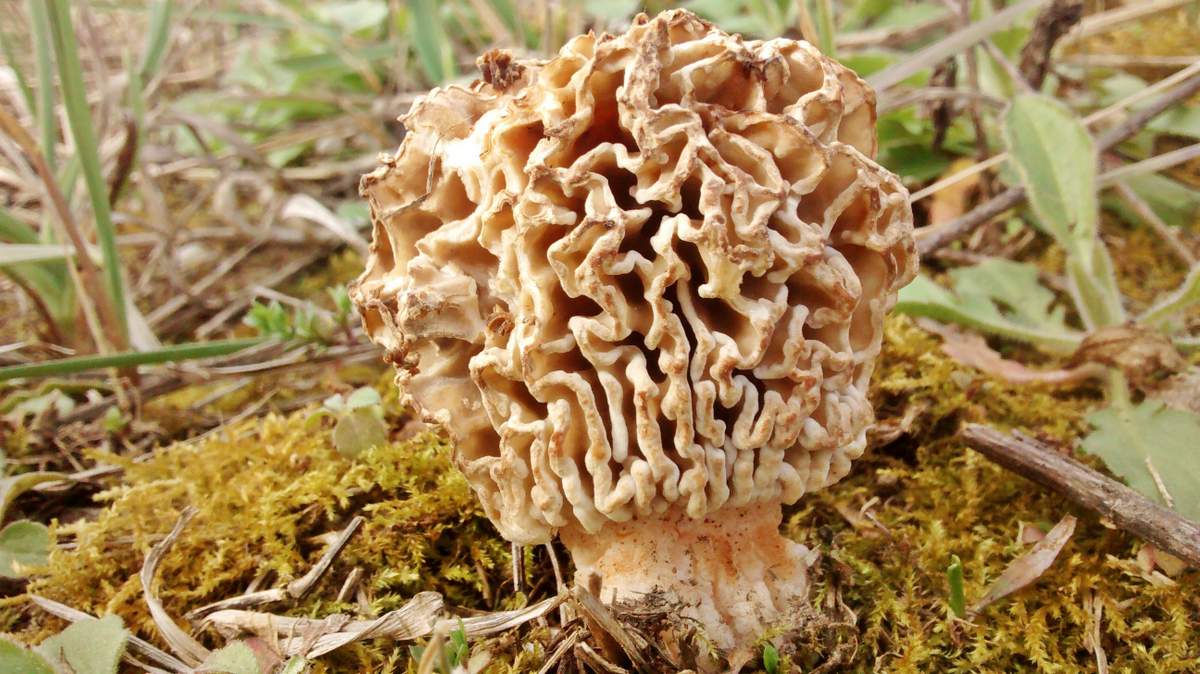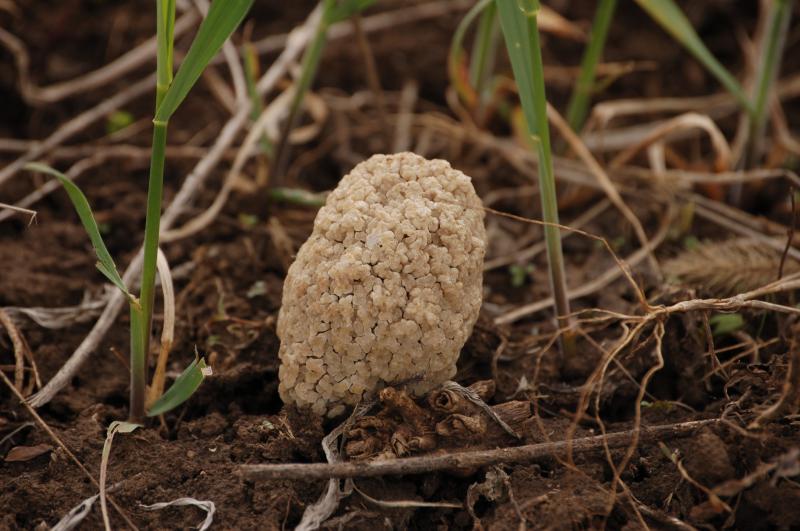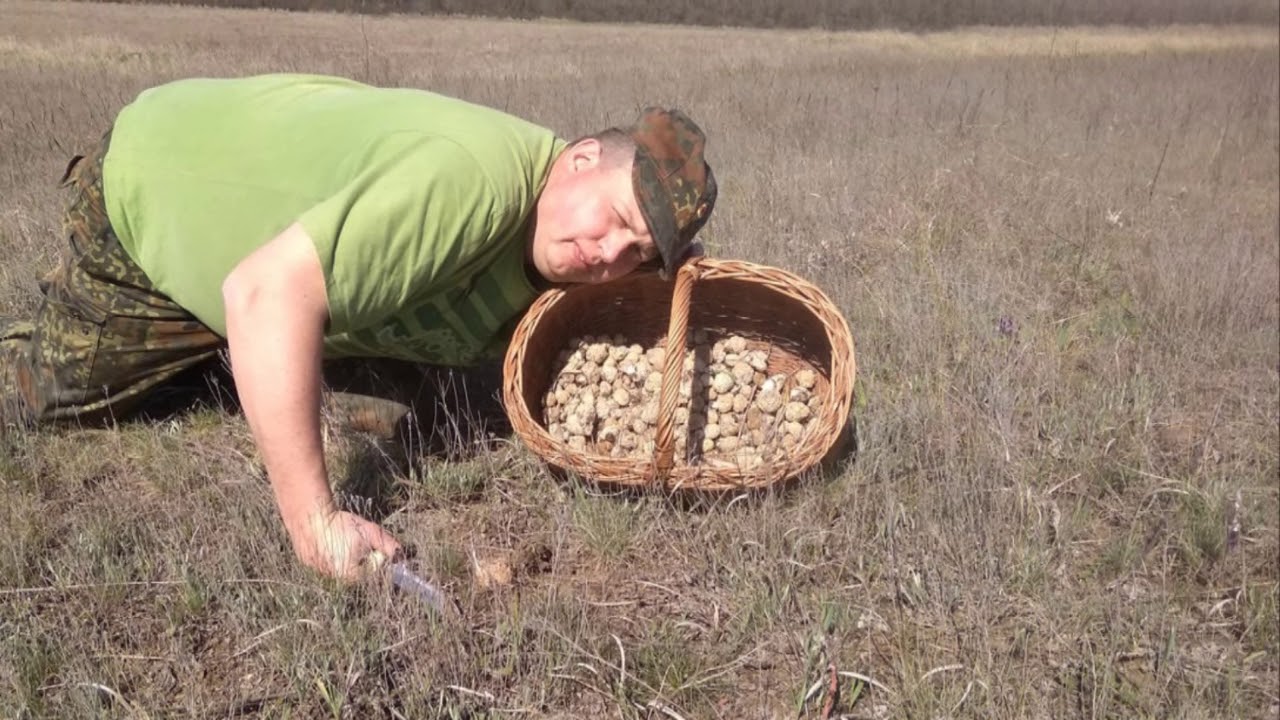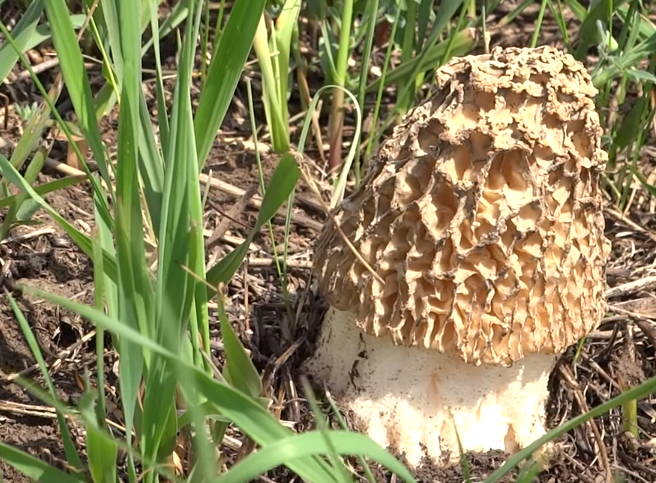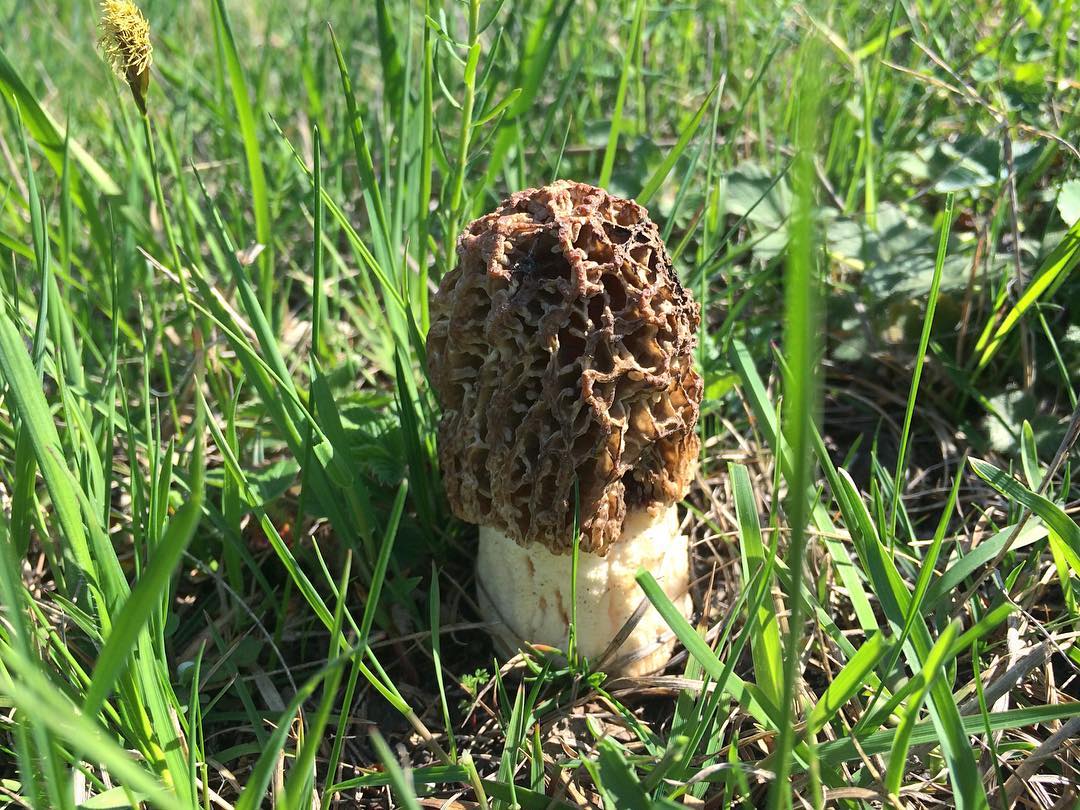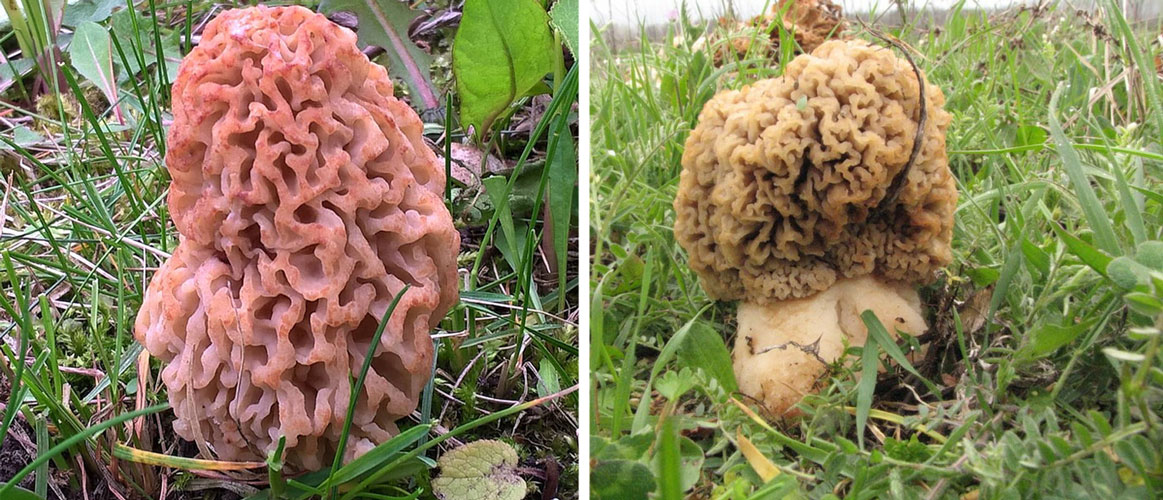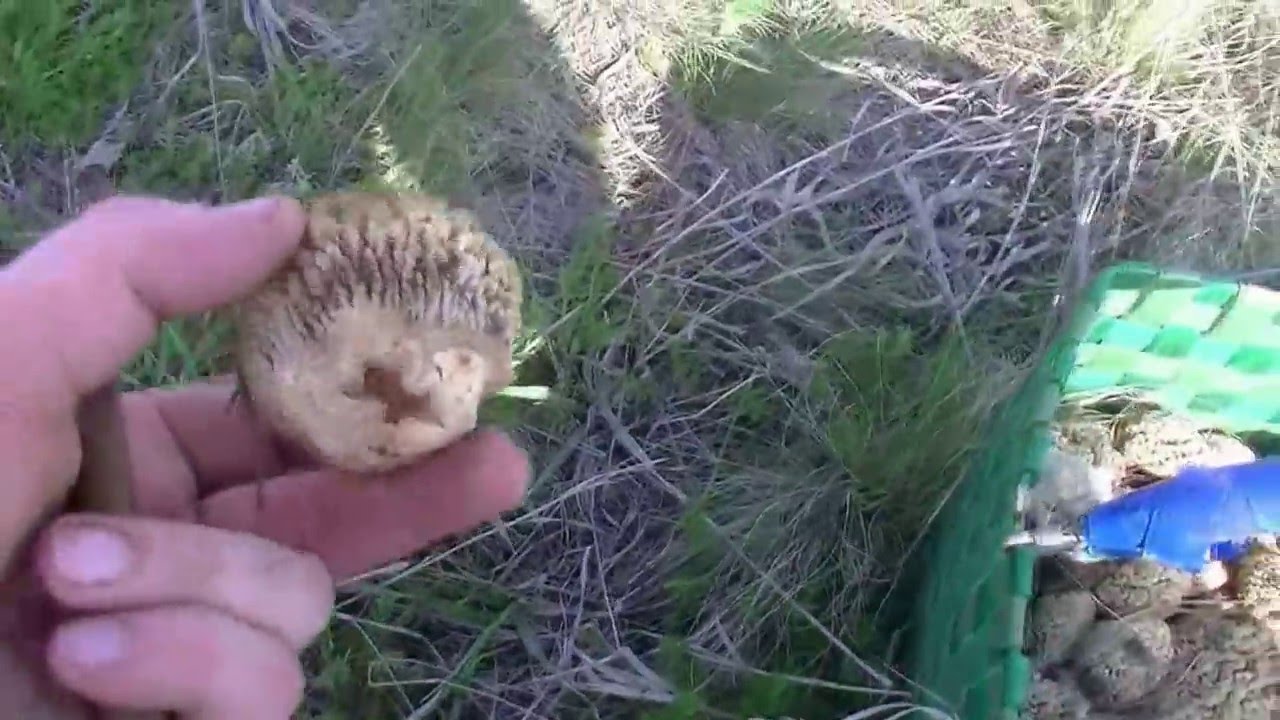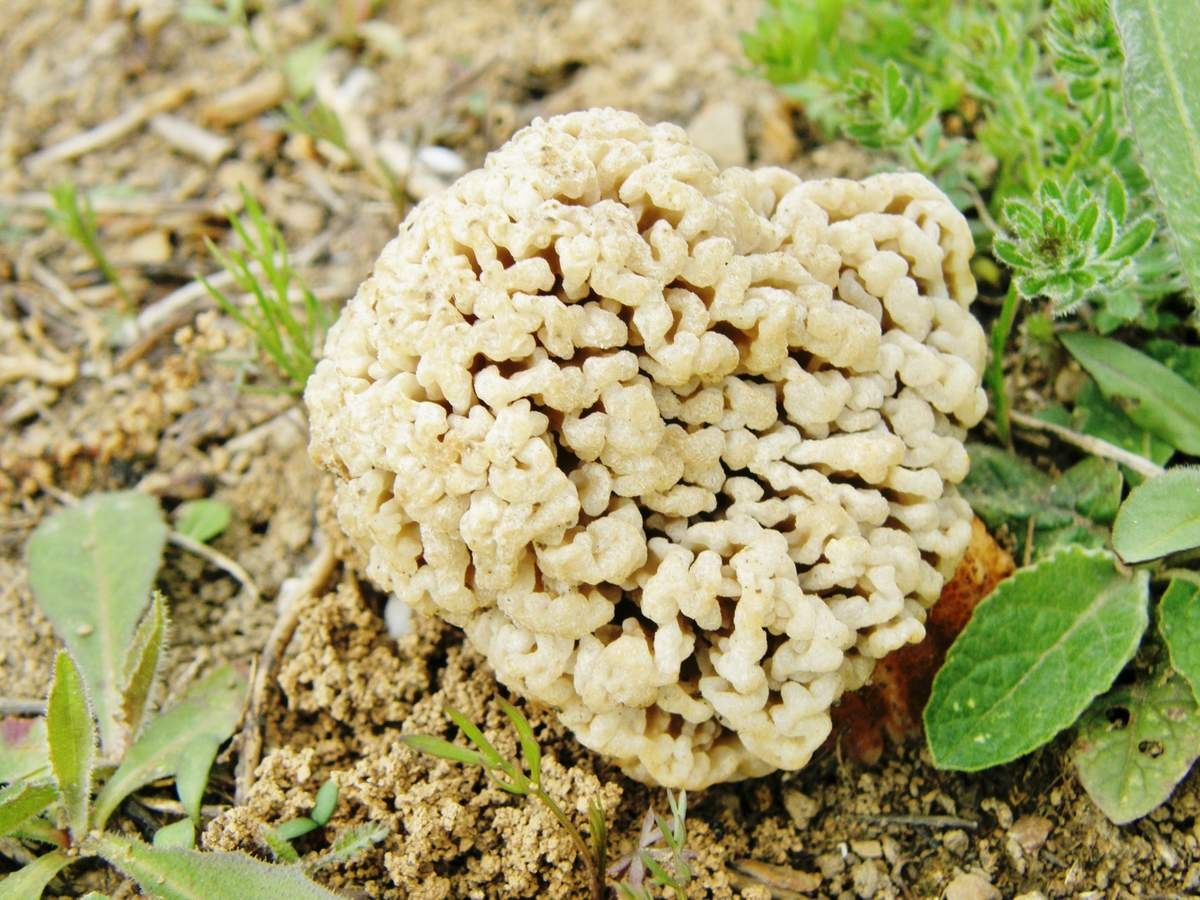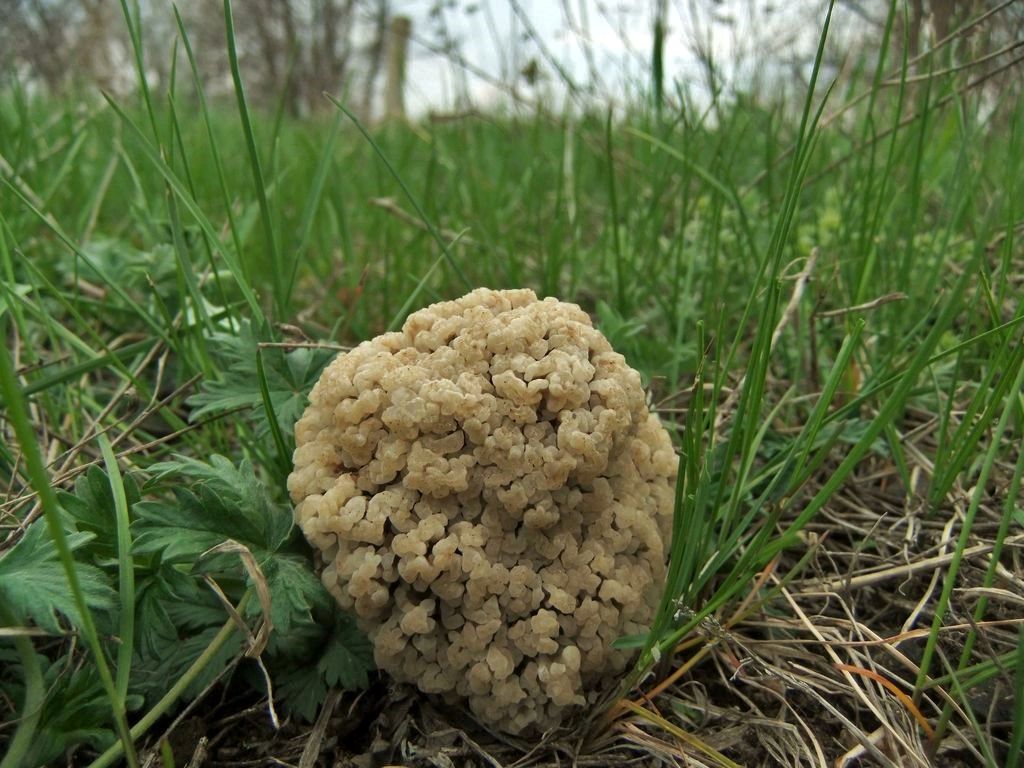Varieties of morels from the photo, are they poisonous?
Unfortunately, the lines and morels differ not only externally, but also internally. The first - it is categorically impossible to use because of the content of poison in the pulp, which is dangerous to the body. The second - can and should be used as food, after heat treatment. Varieties of morels are both edible and conditionally edible species that are acceptable for consumption.
No. 1 - common morel
The classic representative of its species is Morchella esculenta or morel. Its distinctive feature, for many years, has been the fusion of the cap with the stem. A single form distinguishes him from his fellows.
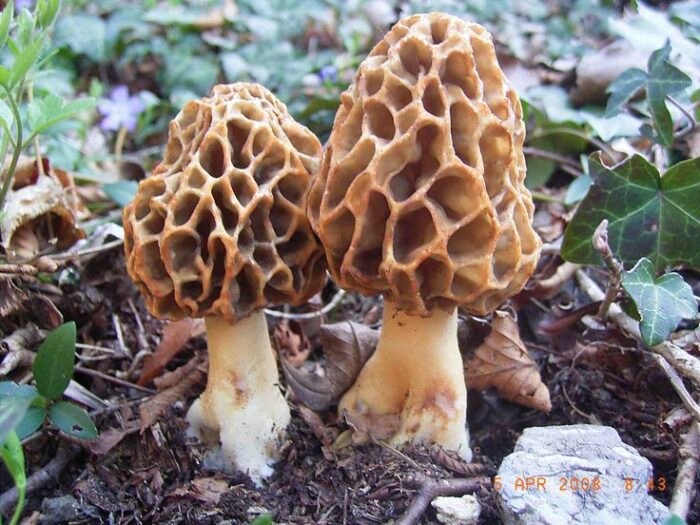
Outwardly, the cap is ovoid, elongated, with cells of varying depth. The leg is light, closer to a snow-white shade, it can reach up to 12 cm in length. Hat - painted in any shades of yellow or brown, from light to dark.
Of the pests found during the germination of the mycelium, slugs and other crawling insects, hiding in the pulp of the cap, are activated. To prevent them from entering food, after harvesting, the mushrooms are washed and soaked in salt water for one hour. The procedure eliminates not only pests, but also dirt adhering to the germination period.
No. 2 - conical morel
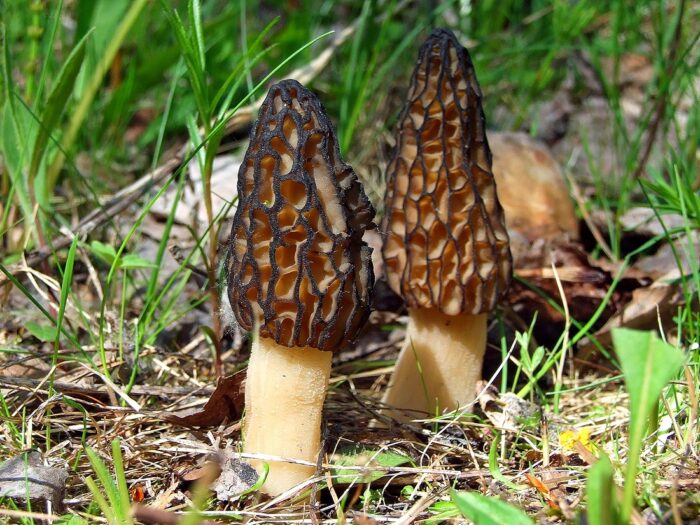
Morchella conica remains a species of the morel family found in humid areas. The conical shape, uniting the cap and the leg, was transferred to the name of the species. Morel is conical, stands out on the ground for the following differences:
a hollow, but cellular cap, having a pointed shape, reaching a length of up to 10 cm, not counting the legs. Usually, the top is larger than the bottom. The color scheme is light yellow, with a slight tint to a brown tone. In rare cases, it can be colored to dark brown;
leg - cylindrical, empty inside. The height is small, in rare cases it reaches 6 cm. The diameter does not exceed 1.5 cm. Externally, it is covered with velvet dusting and longitudinal grooves. The color range is white, less often light yellow.
No. 3 - high morel
A large morel, similar to a conical one, has the unusual name Morchella elata. Translated into Russian, it is characterized as high. The difference between the species remains the dark shade of the cap and the large, one might even say high fruiting body. The length of the "high" reaches up to 35 cm.
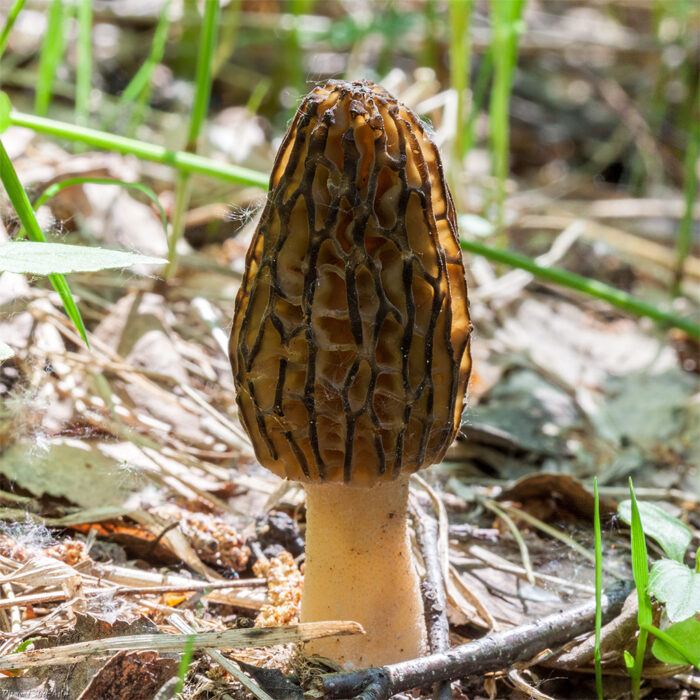
The hat resembles a cone, reaching a length of up to 12 cm, and a diameter of no more than 2.5. Deep cells can be seen on the top of the mushroom. The color scheme is red, less often brown with a black tint. The partitions between the cells are expressive, differing in color from the fruit itself. Often, they have an olive-reddish tone.
The leg is high, slightly larger than the cap. It can be of an elongated form of white, no more than 16 cm. In adult mushrooms, it can be darker, - from cream to light coffee shade.
No. 4 - steppe morel
The name speaks for itself! Morchella steppicola or in common people - the largest morel (photo below), is found almost throughout Russia. It can be found in April and May on vast steppes, fields, marshlands and even forest belts where moss sprouting is observed.

The hat is similar in roundness to the stitching, but has a soft cream shade. In width and height it can reach up to 25 cm.
The leg is of snow-white tones, short and empty. Height in rare cases reaches 2.5 cm.
In order not to confuse the steppe morel with a line that is poisonous or conditionally edible, it is recommended to navigate not only by signs, but also by a visual photo. With a correct visual assessment of the differences, even a beginner will be able to identify an edible mushroom from a prohibited, not recommended for collection.
Beanie Morel Verpa bohemica
Beanie Morel Verpa bohemica
A relative of true morels, although it belongs to a different genus. It is inferior in taste to real morels, but also appreciated among mushroom pickers. It is also called "Cap", "Czech Verpa" and "Tender Morel".
Appearance
The cap has the shape of a cap, with a height of 2 to 5, a diameter of 2 to 4 cm. It is not attached to the bottom of the leg and is very easily removed from it. The hat is covered with vertical folded wrinkles. The color changes from brownish-chocolate in young mushrooms to yellowish-ocher in mature ones.
The stem is smooth and slightly curved, 6 to 10 in length and 1.5 to 2.5 cm in diameter. On the sides it is slightly flattened and covered with small scales. In young mushrooms, the leg is whole, in mature mushrooms, with a cavity inside.
The pulp is light, brittle and thin, it smells very nice. The taste is poorly expressed.
When and where to collect the Morechkovaya Hat
This mushroom bears fruit only from the very end of April and the first half of May, so hunting for it is especially exciting - you need to catch it in time. He is very fond of dampness and does not tolerate the absence of moisture, therefore it grows on flooded soil, in light deciduous and mixed forests, next to aspens, lindens and birches. Look for it in the lowlands near ditches and water pits. A lucky mushroom picker can expect a gift - Caps sometimes grow in a huge herd of up to 80 pieces.
Morels are very tasty mushrooms, when they are fried, such an aroma spreads around the house that people saliva like Pavlov's dog
But there is one IMPORTANT RULE in their preparation.
There is nothing wrong with that, however. The acid is completely destroyed in morels after boiling for 15-20 minutes. In this case, the broth must be poured out - the acid has gone into it. Before boiling, it doesn't hurt to soak the mushrooms for half an hour in cold water - this will wash them off and help eliminate harmful substances in the mushrooms.
Boiled - disinfected morels can be cooked in any way you want. They are good both stewed and fried, and in mushroom soup.
Poisonous varieties
The most toxic and poisonous mushrooms in the marsupial family are:
No. 1 - Ordinary line
Scientifically proven harm from the use of an ordinary line. Its pulp contains the poison gyromitrin, which persists even after heat treatment. Regardless of the amount of boiling and draining of water, toxins do not decompose and can cause irreparable harm to the human body.
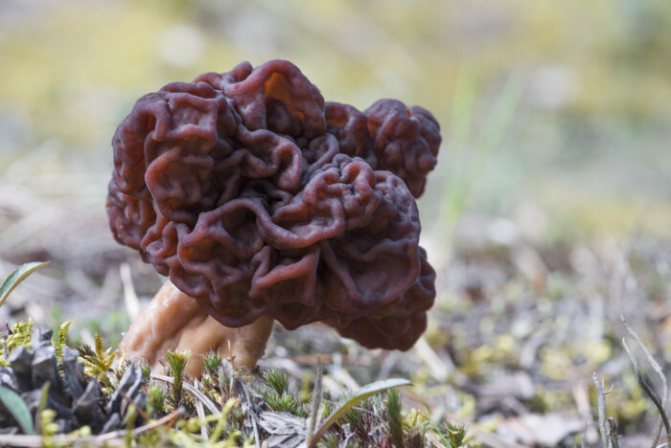
And if in conditionally edible lines, gyromitrin is destroyed when dried at high temperatures. Content in large volumes in an ordinary line does not allow to reduce harm even to a minimum.
The statistics of poisoning and deaths are more common in Germany than in Russia, Belarus and Ukraine. However, cases of intoxication are still registered. Therefore, doctors prohibit the use of fruit pulp, even in small quantities.
№2 - Autumn line
The autumn variety is also included in the list of conditionally edible. The third category is distinguished by the minimum content of toxins that decompose after drying. Boiling for further cooking is highly discouraged. Gyromitrin does not decompose after boiling, even after repeated boiling. The high temperature applied during drying can only destroy a small amount of the poison. The use of this method with poisonous mushrooms is impractical.
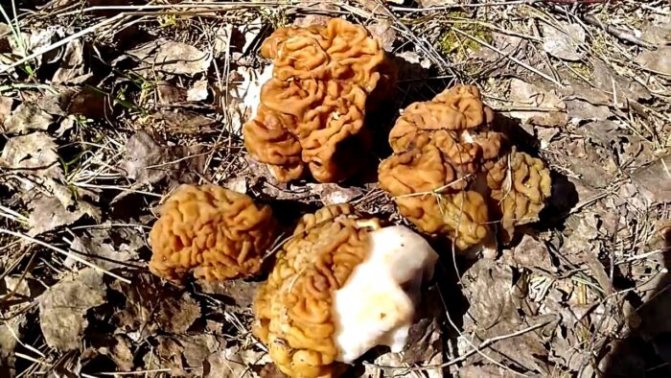
The appearance of the autumn stitching is classic. The hat is large, outwardly similar to the kernel of a walnut. Colored in red, less often in a yellowish-gray shade. The stem is not large, flat and wide, hidden behind the upper part of the fruit.
You can use the stitch after drying in 90-120 days. Only during this period the toxins are completely decomposed.
Description of steppe morel
Steppe morel is the largest among Russian morels. His hat is spherical or egg-shaped, its diameter is 2-10 centimeters, and sometimes it reaches 15 centimeters, while the height corresponds to the diameter.The edge of the cap is adherent, it is hollow inside, it can be divided into sections.
The leg to which the cap is attached is very dense and short - its length does not exceed 1-2 centimeters, sometimes the leg may be absent altogether. The color of the leg is white with a cream shade. There are rare voids inside the leg. The pulp is quite elastic, whitish in color. Spore powder is white or light gray.
Growing places of steppe morels
Steppe morels grow in the European part of our country and in Central Asia. These mushrooms settle in the wormwood steppes. They bear fruit from April to June. When collecting, it is recommended to cut the morels with a knife so that a whole mycelium remains. To find these mushrooms, you have to visit the harvesting sites every day at the beginning of March, otherwise you can skip the beginning of the harvest, and after 3-4 days the season will end altogether.
Fruit bodies in steppe morels develop very quickly, and their lifespan is only 5-7 days, in comparison with ordinary "long-playing" morels, this is extremely small.
In years with humid winters, steppe morels can form "witch circles", consisting of about 20 fruiting bodies, and the diameters of such circles reach 7-8 meters. In dry springs, mushrooms may not appear for several years in a row.
Edibility of steppe morels
Steppe morels are delicious edible mushrooms. They are mushroom delicacies, from which you can prepare independent dishes, as well as sauces and side dishes.
Drying steppe morels is not difficult at all, since they are the densest among other morels. These fungi have practically no internal cavities. The pulp of the steppe morels is similar in consistency to the pulp of the porcini mushroom. Before drying, these mushrooms must be blown out, since there are too many folds and convolutions in their caps, into which sand and dirt are clogged. The sand from the mushrooms simply cannot be shaken out, they are first dried a little in the sun, then they are blown out, and only then they are dried.
Also, these mushrooms can be dried in a special electric dryer, but in the sun they will have a more pronounced mushroom aroma.
If the dried morel is soaked for 8-10 hours, it will completely restore its structure, volume and shape. Steppe morels do not need preliminary boiling. They go well with meat, poultry and fish. Steppe morel powder makes an excellent seasoning for broths, sauces, vegetable and meat dishes. In addition, very tasty mushroom kebabs are obtained from steppe morels.
Other morels
Morel conical - conditionally edible mushroom. His hat is elongated and conical. Its diameter does not exceed 3 centimeters, and its height reaches 10 centimeters. The color of the cap is reddish-brown with a gray or green tint, sometimes the cap may be black. Its surface is cellular, outwardly it looks like a honeycomb. The leg is straight, hollow, white or yellowish.
Conical morels grow on well-heated soils, in clearings and forest fires. Often these mushrooms settle in aspen forests. They bear fruit from April to May. The flesh of conical morels is tasty and soft, but it requires preliminary boiling for 15 minutes.
Morel cap, or cap, or tender morel is a conditionally edible mushroom. A small cap has the shape of a cap, its diameter is 2-4 centimeters, and its height is 2-5 centimeters. The color of the cap at a young age is chocolate brown, and in mature it becomes ocher yellow. The leg is smooth, most often curved, its length is 6-10 centimeters, and its thickness reaches 2.5 centimeters. The leg is often flattened on the sides. With age, an enlarged cavity forms in the leg. The cap and the leg are not firmly connected. The color of the leg is cream or white.
The morel cap is the smallest species in the morel family. These mushrooms bear fruit in mid-May. They often grow among young aspens and lindens. They give preference to poor soils. Under favorable conditions, morel caps are found in large numbers.
Morel hats are eaten only after preliminary boiling, then they can be fried, boiled and cooked in any way. It takes at least a month to dry a morel cap.
Morel mushroom: types and description. Stitching mushrooms and morels: photo and description
Morel - Morchella
An edible mushroom belonging to the Morechkov family.
It is a porous mushroom with a brownish cap that looks like a loofah. The hat rests on a light leg.
Morels are not eaten raw, as they require heat treatment. Some species are considered edible, some are conditionally edible.
They love to grow in old fires, which are already 2-3 years old, but sometimes they grow all year round also in old ones.
Morel common
Where are common morels (Morchella esculenta) harvested: in grassy places of deciduous and mixed forests, more often next to ash, poplar, elm, in bushes, on the edges and in plantings, they grow in groups or singly.
Season: March - May.
The hat has a diameter of 4-8 cm and a height of up to 10 cm. A distinctive feature of the species is an ovoid or conical-bell-shaped cap of light brown or brown color with a cellular surface. The cap grows together with the leg from below. The surface of the cap is cellular-ribbed with elongated rhomboidal cells, similar to a honeycomb, separated from each other by thin partitions.
The leg is 4-12 cm high, 15-30 mm thick, thick and strong, grooved, yellowish or light brown, cylindrical, hollow inside. The base of the pedicle is strongly thickened.
Flesh: whitish, light brown, with a faint pleasant odor.
Variability. The color of the cap varies from light brown and yellow-brown to dark brown.
Similar species. Morel mushrooms by the nature of the surface look like conical morels (Morchella conica). A distinctive feature of the common morel is a relatively large cellular cap, which is attached to the stem along the entire contact plane.
Cooking methods: mushrooms are fried, boiled, canned, dried.
Edible, 3rd category.
Medicinal properties: Similar to conical morels.
These photos show what the common morels look like:
How to use it correctly?
Morels must be properly processed before cooking:
- Go through the collected mushrooms, cut off the tips of the legs.
- Place the mushrooms in a large bowl and cover with clean water.
- Soak them in water for two hours.
- During this time, mix 3-4 times.
- After that, rinse the morels three times, changing the water all the time.
- Transfer to a saucepan, add water, salt, bring to a boil, cook for 10 minutes.
- Drain the water.
- Fill with new water and repeat the procedure.
- Place the cooked morels in a colander.
- Allow excess water to drain.
After that, mushrooms can be used for the first courses, fried, stewed, used in fillings, and cooked mushroom caviar.
If further cooking involves frying in oil, cover the pan with a lid to avoid splashing hot liquid.
Description
Stitch mushrooms (photo in the text) in appearance can be compared to a crumpled sheet of brown paper. The fruit body is very unattractive, crooked and asymmetrical, with deep, gnarled wrinkles, reminiscent of hanging crumpled rags.
The lines belong to the genus of marsupial fungi of the discin family. Organisms that have septic mycelium and specific organs of sexual sporulation - asci - are referred to as ascomycetes (translated from the Greek "bag"). That is why the line is called the marsupial mushroom. This group includes up to 20,000 genera and 30,000 species, including yeast, morels, truffles, and parmelia lichen.

They are not in vain confused with morels - outwardly they are very similar. Only the caps are even more curved and covered with deep curved grooves. Each can have up to four peaks. Its size is usually 2-6 cm, the diameter at the bottom can reach 10 cm. The color is black-brown or yellow-brown, the surface itself is velvety.It is curious that there are no "elevations" of hairs, but in deep (up to 0.5 cm) furrows they are. The lower part of the cap grows together in some places with the stem. The fine and delicate flesh matches the external color.
The legs of mushrooms have irregular stitches with a slight thickening at the bottom, they do not exceed six centimeters in height, up to three centimeters wide, reddish in color, and are also found with a white tint. The leg is deepened into the ground, its surface can be absolutely smooth or pitted with depressions, pits. Some are completely covered with soft fuzz, some are completely naked. The pulp is without a pronounced mushroom odor, fragile, light.
Stitch mushrooms on the territory of Russia are found mainly of two types: giant and ordinary. In some regions, you can find autumn and beam. They differ not only in appearance, but also in the place of growth:
- common (Gyromitra esculenta), prefers pine forests, fires, clearings and other areas well warmed by the sun;
- giant (Gyromitra gigas), grows in the same place as ordinary, but can also be found in coniferous plantings;
- autumn (Gyromitra infula) is found in both deciduous and coniferous forests, grows on the remains of rotting, decaying wood;
- bunch (Gyromitra fastigiata) can be found in mixed or deciduous forests, loves the remains of decaying wood, especially birches and aspens.
Primary processing and cooking recipes
Primary processing of morels is reduced to boiling cut mushrooms (the lower part of the stem is removed) for 10-15 minutes in salted water, which is then drained. If in doubt or with a large number of mushrooms, the procedure is carried out twice, then rinsed under running water. Mushrooms processed in this way are used in the preparation of various dishes.
It is allowed to dry cut morels for 3-4 months until completely dry. Dry morels are stored in boxes or paper bags away from moisture. Powder is prepared from dried mushrooms, which is used as a natural flavoring agent for ready meals.
Stewed morels with sour cream sauce
Ingredients
- 500 g morels;
- 4-5 Art. spoons of sour cream;
- 1 tsp flour;
- frying oil;
- salt and pepper to taste.
Cooking method:
- Pre-boiled morels are fried in hot oil for 15 minutes over medium heat.
- Reduce the heat to a minimum and add flour, fry for 3-4 minutes.
- Season the mushrooms with sour cream and stew for 5-10 minutes under the lid.
- Served with potatoes or pasta.
Morels with potatoes
Ingredients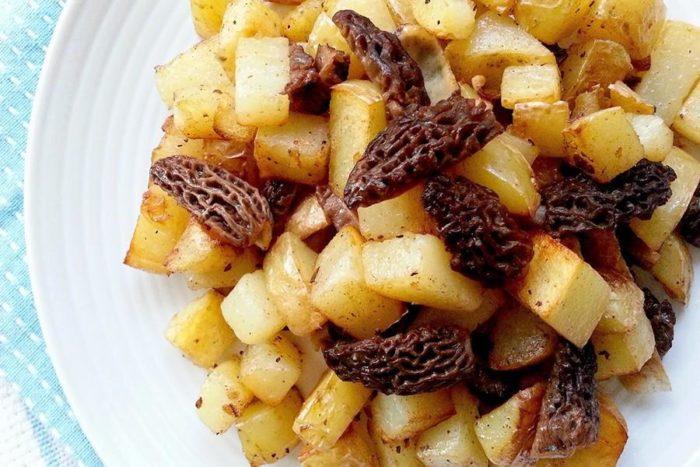
- 400 g morels;
- 2-3 medium potatoes;
- 1 head of onion;
- vegetable oil for frying;
- spices, herbs to taste.
Cooking method:
- Onions are cut in half rings or finely chopped.
- Shredded vegetable is fried in preheated oil until golden brown.
- Add chopped, pre-boiled morels, fry for 5 minutes.
- The potatoes are cut into long strips and added to the onion-mushroom frying.
- The mixture is fried until the potatoes are soft, salt and seasonings are added to taste.
- Before serving, garnish with herbs if desired.
Where and when to look for morels
Morel mushrooms are common in the forest zone of the Northern Hemisphere with a temperate climate. As a rule, morels grow on calcareous soils, which distinguishes them from many other fungi, they need sunlight and moderate moisture. Morels usually hide in the grass, fallen leaves, or behind fallen tree trunks. Most often they grow under deciduous trees, can be found in orchards and parks, grow along streams and rivers. It is rare, but still possible, to find morels in coniferous or mixed forests. You can go in search of morels in early to mid-May, and usually the fruiting season ends in September. Provided a long and warm autumn, morels can be found until the end of October.
Reproduction of morels
Morels reproduce asexually or sexually.
- The asexual method includes reproduction by parts of the mycelium (the body of the fungus) or by conidia (motionless spores).
- Sexual reproduction is carried out with the help of ascospores (cells with half a set of chromosomes), which mature in bags (asci). Mushroom sacs are formed in fruiting bodies (apothecia), the formation of which is preceded by a sexual process called somatogamy. At the same time, vegetative hyphae of different individuals merge.
Morels are not lamellar or tubular mushrooms. Their hymenophore is smooth. The spore-bearing layer (hymen) is located along the bottom and slopes of the ribs and consists of asci with 8 ascospores. Asci are large, cylindrical, rounded at the top. Ascospores are ellipsoidal or spherical, with an uneven surface or smooth, arranged in one row, multinucleated at maturity. Morel spores can be colorless or slightly yellowish. They can be seen under an electron microscope. The release of spores is regulated by solar radiation and occurs gradually.
The life cycle of morels begins with the germination of multinucleated ascospores. The sprout gives rise to the primary haploid multinucleated mycelium, which has existed for a very short time. Ascospores are able to germinate even after prolonged dormancy or storage, after 4-5 years. The hyphae of the primary mycelium of morel form anastomoses (connection of two hyphae of one mycelium) or merge with the hyphae of another primary mycelium. As a result of the fusion, a diploid multinucleated organism emerges. In the future, he is able to enter into symbiosis with higher plants, form conidial sporulation or sclerotia (dormancy stage). The main reason for the formation of sclerotia is the lack of nutrients in the soil. In the life cycle of morels, the asexual (vegetative) stage prevails.
What is the difference between morels and lines?
Lines (Latin Gyromitra) are mushrooms that are often confused with morels. Both of them appear at approximately the same time. They are sold on the market under the general name "morels". But the lines are more poisonous, especially when raw, and in some countries they are even classified as inedible. Below are the differences between these mushrooms.
- The surface of the cap does not contain cells, it is sinuous-wavy (similar to the brain or a peeled walnut), asymmetrical and does not grow to the stem. In morels, this part of the mycelium has a more regular shape, it is covered with convex ribs of cells of different depths, and in almost all species it grows to the stem.
- The color of the cap line is yellow-brown, brown, less often brown or grayish, often with a reddish tint. In the morel, it is dirty grayish white or dark brown.
- You can also distinguish the morel from the stitching by the leg. The stitch leg is shorter (3-6 cm) and thicker (up to 5 cm in diameter). It is uneven and often swollen at the base. Sometimes it doesn't exist at all. The morel has a leg about the length of the cap. She is also more slender.
- The body of the line is not hollow inside: it is filled with septa and convolutions. On the cut, it is white with a purple tint. The cap and stem of the morel are usually empty inside, and the flesh of the mushroom is white, waxy and fragile.
Types of morels and stitches
Morel ordinary, or edible, real (Morchella esculenta)

Edible mushroom.
The weight of the mushroom reaches 500 g. The diameter of the cap is 3-5 cm, the shape is ovoid or ovoid-round. The edge of the cap grows together with the leg. The color of the cap is yellow-brown, brown, rarely gray-brown. The surface is reticulated. The leg is fragile, up to 7 cm high, about 2 cm thick, cylindrical, hollow, whitish or brownish, smooth or furrowed, widens towards the base. The pulp is thin, fragile, wax-like. The hat and the leg are the same in height. The inside of the mushroom is hollow.
Morel conical (Morchella conica)
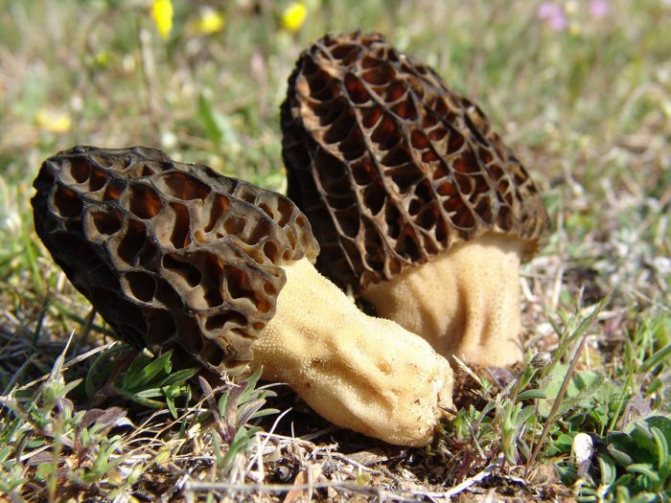
Edible mushroom.
The cap grows together with the stem, brownish or brownish-gray, eventually turns brown. Diameter about 5 cm, height up to 10 cm, conical or oblong-ovoid shape. The surface is cellular or ribbed. The pulp is waxy, has a weak mushroom odor.The leg is 2-5 cm long, 1.5-3 cm thick, cylindrical, hollow, whitish or yellowish, fragile. The surface is smooth or notched.
Morel cap (Verpa bohemica)
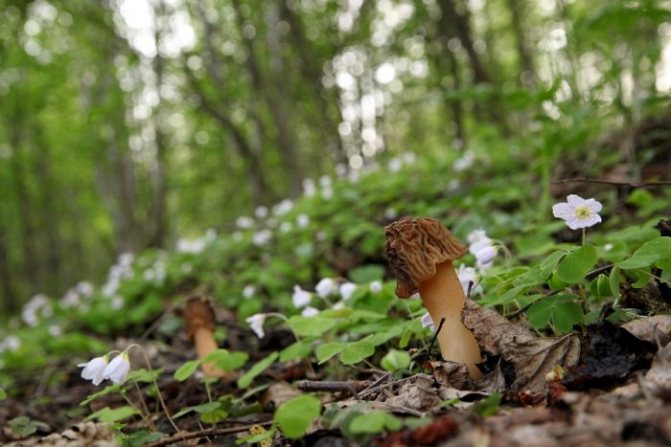
Edible mushroom.
Found in deciduous forests, often under aspen trees. The cap is brown or yellowish-brown, up to 5 cm in diameter. It looks like a bell, the surface is folded, the edge is wavy-sinuous. The cap is attached to the leg only in the center. The leg is 6-14 cm high, about 2 cm thick, cylindrical, whitish or whitish-yellowish, smooth or pubescent. Hollow inside. The mushroom has a pleasant smell.
High morel (Morchella elata)
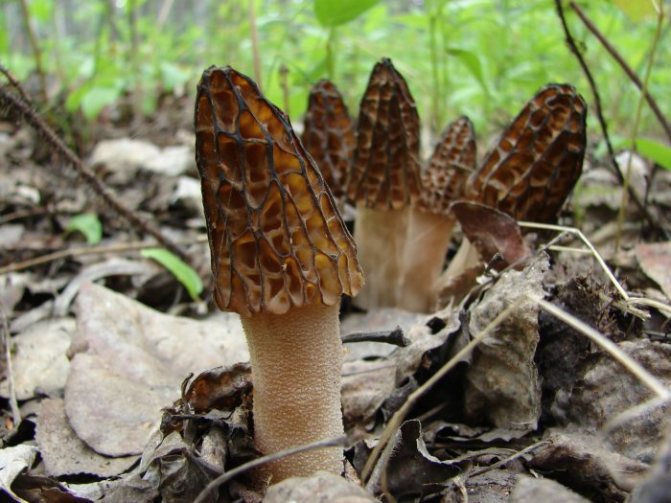
Conditionally edible mushroom.
The cap is narrow, conical, 4-10 cm in height, 3-5 cm in diameter. The surface is covered with olive-brown cells, in mature mushrooms they turn brown or black-brown. The stem is cylindrical, granular, 5-15 cm long and 3-4 cm in diameter. In young mushrooms, the leg is whitish in color; as it grows, it becomes yellowish or ocher.
Fruiting in April-May. A rare species, found on the soil of coniferous and deciduous forests, in glades and forest edges, in gardens and vegetable gardens. Grows in the mountains.
Giant stitching (Gyromitra gigas)

Conditionally edible mushroom.
The fruit body looks like a brain or a walnut. The cap is covered with convolutions, hollow, irregularly rounded, folded, with a velvety surface, yellowish or yellowish-ocher color. Diameter 8-30 cm, the edge is connected to the leg. The leg is irregular in shape, short and wide, the surface is furrowed-folded, hollow inside, whitish in color. The pulp is thin, brittle, waxy, has a pleasant mushroom aroma.
The fruiting season coincides with the morels. This is a spring mushroom. Grows in groups in deciduous and mixed forests, often near birches, in Europe and North America.
Ordinary line (Gyromitra esculenta)

Conditionally edible mushroom.
A cap of irregular shape, like a brain, up to 10 cm high, about 15 cm in diameter. In young mushrooms, it becomes smooth, wrinkled as the mushroom matures. The color of the cap is brown, occasionally red, orange or purple. The leg is 2-3 cm long, 2-6 cm in diameter, even, hollow inside, tapers towards the base. Light, with a pink tint. The pulp is waxy, brittle, the taste is pleasant, the smell is fruity.
It grows on sandy soils, in places of deforestation, under conifers and poplars. Found in Europe, Asia and North America.
Poisonous and inedible species of morels and stitches
Autumn stitching (Gyromitra infula)
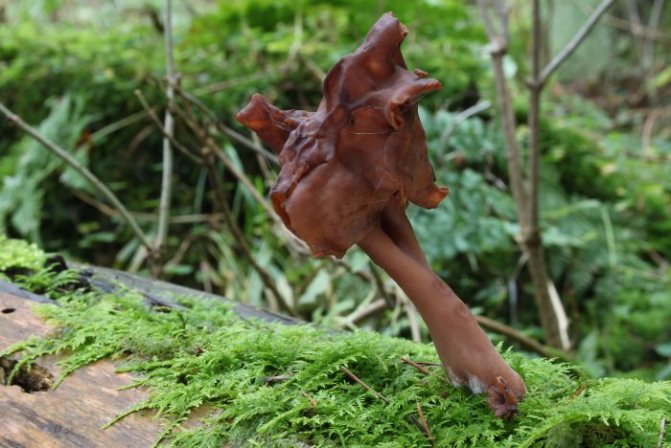
Poisonous mushroom.
The cap is 2.5-10 cm in diameter, the shape is saddle-shaped or irregular, 2-4-lobed, the edge is tucked up, adheres to the stem. The surface is red-brown or dark brown, wrinkled, pale underneath, velvety to the touch. The flesh is grayish, thin. Leg 2-6 cm long and 2-3 cm in diameter, hollow, fine-grained, whitish with a pink tint.
Grows on soil and decaying wood of deciduous and coniferous species, bears fruit in autumn. Found in Eurasia and North America.
Morel (Morchella esculenta)
Synonyms:
The fruit body of the edible morel is large, fleshy, hollow inside, which is why the mushroom is very light in weight, 6-15 (up to 20) cm high. Consists of a "leg" and "cap". Edible morel is considered one of the largest mushrooms in the morel family.
The cap of an edible morel, as a rule, has an ovoid or ovoid-rounded shape, less often a flattened-spherical or spherical; along the edge grows tightly to the leg. The height of the cap is 3-7 cm, the diameter is 3-6 (up to  see the color of the cap from yellow-brown to brown; becomes darker with age and drying. Since the color of the cap is close to the color of the fallen leaves, the fungus is hardly noticeable in litter. The surface of the cap is very uneven, wrinkled, consisting of deep pits-cells of various sizes, lined with hymenium. The shape of the cells is irregular, but closer to round; they are separated by narrow (1 mm thick), sinuous folds-ribs, longitudinal and transverse, colored lighter than the cells.The cells vaguely resemble a honeycomb, hence one of the English names for edible morel - honeycomb morel.
see the color of the cap from yellow-brown to brown; becomes darker with age and drying. Since the color of the cap is close to the color of the fallen leaves, the fungus is hardly noticeable in litter. The surface of the cap is very uneven, wrinkled, consisting of deep pits-cells of various sizes, lined with hymenium. The shape of the cells is irregular, but closer to round; they are separated by narrow (1 mm thick), sinuous folds-ribs, longitudinal and transverse, colored lighter than the cells.The cells vaguely resemble a honeycomb, hence one of the English names for edible morel - honeycomb morel.
Morel stem is cylindrical, slightly thickened at the base, hollow inside (makes up a single cavity with a cap), fragile, 3-7 (up to 9) cm long and 1.5-3 cm thick. Young mushrooms have whitish stem, but darkens with age becoming yellowish or creamy. A fully ripe mushroom has a brownish, mealy or slightly flaked stem, often with longitudinal grooves at the base.
The pulp of the fruiting body is light (whitish, whitish-cream or yellowish-ocher), waxy, very thin, fragile and delicate, easily crumbles. The taste of the pulp is pleasant; there is no distinct smell.
Spore powder, yellowish, light buffy. Spores are ellipsoidal, smooth, less often granular, colorless, (19-22) × (11-15) microns in size, develop in fruit bags (asci), forming a continuous layer on the outer surface of the cap. Asci are cylindrical, 330 × 20 microns in size.
Edible morel is distributed throughout the temperate zone of the Northern Hemisphere - in Eurasia up to Japan and North America, as well as in Australia and Tasmania. Occurs singly, rarely in groups; quite rare, although the most common among morel mushrooms. It grows in well-lit places on fertile, lime-rich soil - from lowlands and river floodplains to mountain slopes: in light deciduous (birch, willow, poplar, alder, oak, ash and elm), as well as in mixed and coniferous forests, in parks and apple orchards; common in grassy, sheltered places (on lawns and forest edges, under bushes, in clearings and clearings, near fallen trees, along ditches and along the banks of streams). It can grow in sandy areas, near landfills and in places of old burnt places. In southern Russia, it is found in vegetable gardens, front gardens and lawns. This fungus develops abundantly in spring, from mid-April to June, especially after warm rains. It is usually found in forests on more or less fertile soil under deciduous trees, more often in grassy, well-protected places: under bushes, along ditches, on lawns in parks and gardens.
In Western Europe, the mushroom is found from mid-April to the end of May, in especially warm years - from March. In Russia, the mushroom usually appears not earlier than the beginning of May, but can occur until mid-June, occasionally, in a long warm autumn, even in early October.
Edible morel cannot be confused with any poisonous mushroom. From related species, the morel is conical and the morel is tall, it is distinguished by the rounded shape of the cap, the shape, size and arrangement of the cells. The round morel (Morchella rotunda) is very similar to it, which, however, is often considered as a form of edible morel.
Conditionally edible mushroom of the third category. Suitable for food after boiling in boiling salted water for 10-15 minutes (the broth is drained), or after drying without boiling.
Video about the Morel mushroom edible:

